Resources
Find the latest news & updates on AWS

Cloudtech Has Earned AWS Advanced Tier Partner Status
We’re honored to announce that Cloudtech has officially secured AWS Advanced Tier Partner status within the Amazon Web Services (AWS) Partner Network!
We’re honored to announce that Cloudtech has officially secured AWS Advanced Tier Partner status within the Amazon Web Services (AWS) Partner Network! This significant achievement highlights our expertise in AWS cloud modernization and reinforces our commitment to delivering transformative solutions for our clients.
As an AWS Advanced Tier Partner, Cloudtech has been recognized for its exceptional capabilities in cloud data, application, and infrastructure modernization. This milestone underscores our dedication to excellence and our proven ability to leverage AWS technologies for outstanding results.
A Message from Our CEO
“Achieving AWS Advanced Tier Partner status is a pivotal moment for Cloudtech,” said Kamran Adil, CEO. “This recognition not only validates our expertise in delivering advanced cloud solutions but also reflects the hard work and dedication of our team in harnessing the power of AWS services.”
What This Means for Us
To reach Advanced Tier Partner status, Cloudtech demonstrated an in-depth understanding of AWS services and a solid track record of successful, high-quality implementations. This achievement comes with enhanced benefits, including advanced technical support, exclusive training resources, and closer collaboration with AWS sales and marketing teams.
Elevating Our Cloud Offerings
With our new status, Cloudtech is poised to enhance our cloud solutions even further. We provide a range of services, including:
- Data Modernization
- Application Modernization
- Infrastructure and Resiliency Solutions
By utilizing AWS’s cutting-edge tools and services, we equip startups and enterprises with scalable, secure solutions that accelerate digital transformation and optimize operational efficiency.
We're excited to share this news right after the launch of our new website and fresh branding! These updates reflect our commitment to innovation and excellence in the ever-changing cloud landscape. Our new look truly captures our mission: to empower businesses with personalized cloud modernization solutions that drive success. We can't wait for you to explore it all!
Stay tuned as we continue to innovate and drive impactful outcomes for our diverse client portfolio.
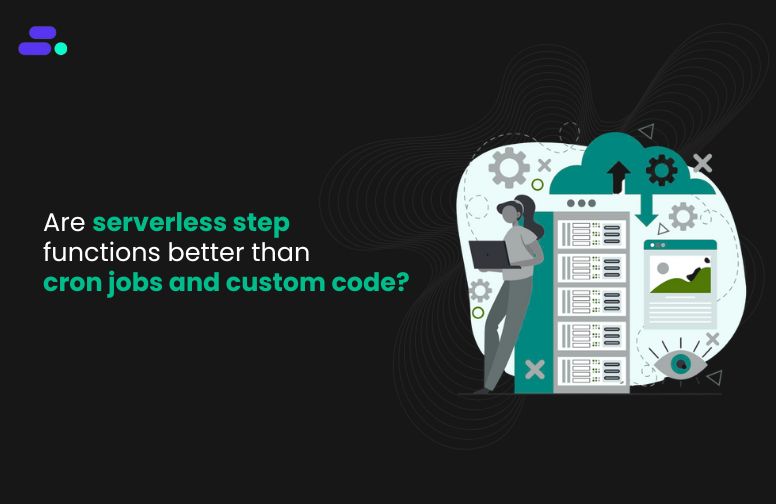
Why are SMBs choosing serverless step functions over cron jobs and custom code?
Backend automation mostly starts with quick fixes using cron jobs, custom scripts, or ad-hoc code. But as systems grow, these solutions become brittle, hard to debug, and tough to scale.
Consider a patient intake process, which includes verifying insurance, updating EHRs, and notifying staff. With cron jobs or custom code, failures might go unnoticed until they impact care. Serverless Step Functions offer a better path with automated, scalable workflows that handle errors, retries, and dependencies without constant oversight.
SMBs can design these processes as visual, reliable workflows, fully managed, event-driven, and scalable by default. No more maintaining background scripts or worrying about what happens if a step fails at 3 AM.
This article explores why SMBs are making the shift from legacy automation methods to serverless step functions, and how this move is helping them streamline operations.
Key takeaways:
- AWS Step Functions simplify workflow automation by coordinating tasks like validation, API calls, and notifications without managing servers.
- Built-in error handling and retries ensure processes run reliably, reducing manual rework and system downtime.
- Parallel execution boosts efficiency, allowing multiple tasks (like scheduling and notifications) to run simultaneously.
- AWS Step Functions scales automatically, making it ideal for SMBs looking to grow without adding operational overhead.
- Working with an AWS Partner like Cloudtech accelerates implementation and ensures automation aligns with real SMB goals.
The hidden costs of cron jobs and custom glue code
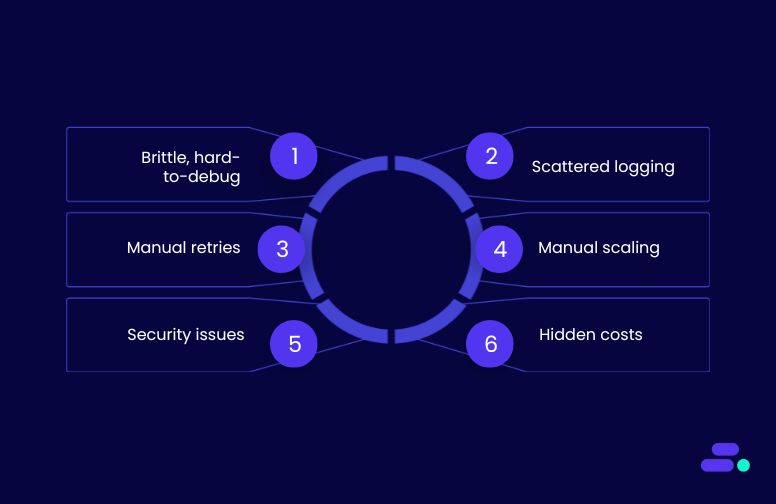
At first, cron jobs and glue code feel like quick wins. They’re simple, familiar, and seem to get the job done. But over time, what starts as a straightforward script might turn into a fragile patchwork that introduces more problems than it solves, especially for growing businesses operating in the cloud.
The operational pain points behind the scenes:
- Brittle and hard to debug: Cron jobs lack built-in error handling or visibility. If a task fails silently at 2 a.m., teams may not know until users complain, or worse, sensitive workflows go incomplete.
- Scattered logging and monitoring: Logs are often stored across different systems (or nowhere at all), making it hard to trace issues or maintain compliance. Debugging becomes time-consuming and frustrating.
- Manual retries and failure recovery: When a job fails, someone has to step in and manually re-trigger it or fix the data it left half-processed. This reactive approach slows teams down and increases risk.
- Scaling is manual or non-existent: Most cron jobs run on fixed infrastructure. As load increases, performance suffers, or teams need to intervene to scale manually, neither of which supports agility.
- Security and access management headaches: Scripts and jobs often use hardcoded credentials or shared environments, creating security gaps that are difficult to audit or manage.
- Hidden maintenance costs: Over time, teams spend more effort maintaining brittle code than delivering new features. And when the person who wrote the job leaves, knowledge often walks out the door too.
Why this doesn’t scale in the cloud: Modern cloud-native environments thrive on automation, observability, and scalability. Cron jobs and glue code weren’t designed for this. They may seem like the fastest route early on, but they’re rarely the most sustainable or cost-effective as the business grows.
That’s why SMBs are shifting toward orchestrated, serverless solutions like AWS Step Functions. They offer a structured, fault-tolerant way to automate complex workflows, with less operational baggage.

How do AWS Step Functions deliver scalable, reliable, and maintainable workflows?
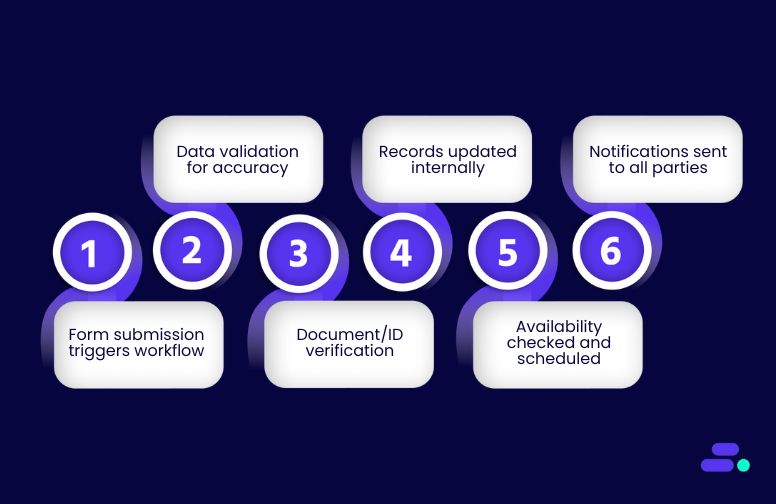
As SMBs grow, so do the demands on their backend systems. What once worked with a few cron jobs or scripts often becomes a tangled web of logic. For lean teams, especially in regulated industries, even a minor workflow failure can lead to compliance risks, lost productivity, or customer frustration.
To better understand the relevance of serverless step functions over cron jobs and custom code, take the example of a growing healthcare clinic. Onboarding a new patient involves several steps, many of which were traditionally manual or loosely automated. With AWS Step Functions, that is no longer the case:
Step 1: Intake form submission triggers the workflow
The patient intake journey begins the moment someone fills out an online form, maybe on a clinic’s website or patient portal. Traditionally, this would require backend polling, manual data entry, or cron-based checks to process form submissions. With AWS Step Functions, the process becomes instant, event-driven, and serverless.
Here’s how it works behind the scenes:
- Amazon API Gateway receives the HTTP POST request from the form and acts as the front-door to the workflow, providing a secure and scalable entry point.
- AWS Lambda processes the incoming request, sanitizes data if needed, and then directly starts the Step Function execution using the AWS SDK.
- AWS Step Functions picks up the baton immediately, no need for persistent infrastructure or background schedulers to monitor form submissions.
Outcome: The moment a patient submits the form, the automation begins in real time. This ensures no delays, removes the need for backend polling scripts, and guarantees that no intake request falls through the cracks, even during peak load. It's fast, secure, and fully managed from the first click.
Step 2: Validate patient data
After intake submission, the next critical step is validating patient information. This includes ensuring required fields are present, checking for formatting errors, and verifying identifiers like insurance numbers. In many SMB healthcare setups, this would typically involve handwritten scripts or manual admin review, both prone to error and delay. With AWS Step Functions, validation becomes automated, consistent, and fault-tolerant.
Here’s how AWS handles this step:
- AWS Lambda handles validation logic, such as checking for missing fields, malformed contact details, or mismatched insurance number formats.
- AWS Step Functions' built-in error handling automatically catches failures and retries based on a configurable policy, no need for custom retry logic or manual intervention.
- ResultPath and Catch blocks in AWS Step Functions allow seamless branching, sending invalid entries to a remediation workflow or alert queue without breaking the entire process.
Outcome: Patient data is reviewed and validated in real time, with failed attempts retried automatically and consistently. This reduces human error, saves staff time, and ensures that only clean, verified data moves forward, essential for compliance, billing, and patient safety.
Step 3: Document verification
Once patient data is validated, the next step is verifying supporting documents such as ID proof, insurance cards, or medical history forms. In traditional SMB environments, this often involves email attachments, manual uploads, or local storage, all of which are error-prone and hard to scale. With AWS, this entire step becomes automated and intelligent.
Here’s how AWS handles this step:
- Amazon S3 securely stores uploaded documents, providing durable, scalable storage that integrates easily with downstream services.
- AWS Lambda picks up the file event and invokes Amazon Textract, which automatically extracts key identity data (e.g., name, date of birth, insurance details) using AI-powered OCR.
- AWS Step Functions monitors the output from Textract. If the document is unreadable or incomplete, it routes the case to a manual review queue (e.g., via Amazon SQS or a custom admin dashboard), ensuring the rest of the workflow continues unaffected.
Outcome: SMBs can automate identity verification without compromising on accuracy or compliance. The system intelligently handles bad scans or missing info without disrupting the broader process, freeing up staff to focus only on exceptions while scaling smoothly during high patient volumes.

CTA Button Link:
Step 4: Patient record update in EHR
After verifying documents, the final step in onboarding is updating the patient’s information in the clinic’s Electronic Health Record (EHR) system. Traditionally, this might involve a staff member manually entering data into multiple systems, which is a time-consuming and error-prone process. With Step Functions, this step is programmatically automated and resilient to failure.
Here’s how AWS handles this step:
- AWS Lambda packages the verified patient data and makes a secure API call to the external EHR system. This could be a RESTful endpoint exposed by a third-party provider.
- AWS Step Functions defines retry logic using exponential backoff and timeout policies. If the EHR system is temporarily down or responds with an error, the function automatically retries without manual intervention.
- Failure handling is built in. If all retries fail, the Step Function can trigger an alert (e.g., via Amazon SNS) or route the request to a dead-letter queue for follow-up.
Outcome: The patient record is updated in real time, reliably and securely. Even if the external system is intermittently unavailable, the workflow stays resilient, reducing admin effort, preventing data loss, and ensuring compliance with healthcare data handling requirements.
Step 5: Check appointment availability and schedule
Once patient records are updated, the next step is to schedule their appointment, often a bottleneck when done manually or handled sequentially in code. With AWS Step Functions, this part of the workflow can be both parallelized and automated, improving speed and patient experience.
Here’s how AWS handles this step:
- AWS Lambda invokes the appointment scheduling microservice (or API) to check for available time slots based on doctor schedules, patient preferences, or clinic hours.
- AWS Step Functions' Parallel State enables this to run alongside other actions like sending a confirmation email or updating the CRM without waiting for one to finish before the other starts.
- Conditional branching can be added if no slots are available. For e.g., prompt the patient to choose another time or notify staff for follow-up.
Outcome: The system instantly finds a matching slot and confirms the appointment, while other tasks (like sending notifications) continue in parallel. This reduces patient wait times, eliminates scheduling delays, and enables the clinic to operate more efficiently even during peak hours.
Step 6: Notify patient and staff
Once the appointment is locked in, timely communication is critical, not just for patient experience, but also for operational coordination. Instead of relying on separate tools or manual follow-ups, AWS Step Functions lets users automate this step with full traceability.
Here’s how AWS handles this step:
- AWS Lambda sends a confirmation email to the patient using a service like Amazon SES or a third-party provider integrated via API.
- Amazon SNS (Simple Notification Service) is optionally triggered to send an SMS alert, either to the patient, front-desk staff, or both.
- AWS Step Function execution history captures every notification attempt, making it easy to audit or troubleshoot if a message fails to send.
Outcome: Every stakeholder receives timely updates, and the entire process is visible in one place. No more guesswork, missed messages, or siloed systems. Notifications are consistent, auditable, and automated, ensuring patients feel cared for and staff stay informed.
Do these benefits apply for SMBs in other sectors?
While the above use case followed a healthcare clinic automating patient intake and scheduling, the same workflow structure applies to SMBs across industries. Whether it’s a logistics firm automating shipment tracking, a financial services company validating KYC documents, or an e-commerce business handling returns, the building blocks remain the same:
- An event (form submission, file upload, payment, etc.) triggers a Step Function using API Gateway and Lambda.
- The workflow automatically coordinates the required steps, from validation to external API calls to notifications.
- Tasks run in parallel where possible, and errors are handled without human intervention.
The real power lies in how AWS Step Functions deliver enterprise-grade orchestration with zero infrastructure burden.
For the healthcare SMB, this means no more background scripts or fragile cron jobs. For other SMBs, it means reliable, scalable, and auditable workflows without hiring an ops team. With AWS Step Functions, automation becomes a strategic asset, not a maintenance headache.

Even if SMBs are unsure of how the transition to AWS Step Functions affects their workflow, AWS partners like Cloudtech can help them with the implementation. With deep expertise in architecting serverless workflows, Cloudtech helps SMBs design and implement automation that’s reliable from day one.
Why do SMBs trust Cloudtech to implement step functions right?

Orchestrating complex workflows with AWS Step Functions isn’t just about wiring services together, it’s about designing for scalability, resilience, and long-term maintainability from day one. That’s where Cloudtech, an AWS Advanced Tier Services Partner built exclusively for SMBs, brings unique value.
As a managed cloud partner, Cloudtech helps small and mid-sized businesses go beyond automation experiments to real-world, production-ready outcomes. Here’s how:
- SMB-native support model: Lean teams get 24/7 monitoring, fast incident response, and patch management, without enterprise complexity or vendor lock-in.
- Resilience and security baked in: Every Step Function architecture includes IAM best practices, automated retries, backup strategies, and multi-AZ failover.
- Cost and performance optimization: Cloudtech continuously tunes workflows using tools like AWS CloudWatch, Trusted Advisor, and X-Ray, ensuring automation stays efficient as businesses grow.
- Guided enablement: Beyond implementation, Cloudtech helps SMBs build internal confidence, offering knowledge transfer, architectural clarity, and proactive recommendations.
With Cloudtech, SMBs gain more than a serverless workflow. They gain a strategic partner that helps turn AWS automation into a business advantage.
See how other SMBs have modernized, scaled, and thrived with Cloudtech’s support →

Wrapping up
Serverless automation with AWS Step Functions gives SMBs the ability to streamline operations, reduce errors, and scale workflows without managing infrastructure. But unlocking that value consistently requires more than tools. It takes guidance, experience, and a partner who understands the unique needs of growing businesses.
That’s where Cloudtech comes in. As an AWS Advanced Tier Partner focused solely on SMBs, Cloudtech doesn’t just deploy automation, it delivers long-term business value. With a proactive, cost-conscious approach to managed services, they help SMBs move faster, operate smarter, and avoid the common pitfalls of DIY cloud.
When operations are on autopilot, innovation can take the driver’s seat. Ready to make your workflows more resilient, and your business more agile? Get on a call and find out how Cloudtech can help you scale with confidence.
FAQs
1. Do SMBs need coding expertise to use AWS Step Functions?
Not always. While defining workflows typically involves JSON using Amazon States Language (ASL), AWS also provides a visual editor that makes it easy to view and manage workflows. With the right AWS Partner, even teams with limited coding resources can implement and operate Step Functions effectively.
2. Can Step Functions integrate with existing SMB systems?
Yes. Step Functions integrate easily with both AWS services and external systems via Lambda functions, API Gateway, and SDKs. Whether an SMB uses ERP platforms, CRMs, or industry-specific tools, workflows can be designed to automate and orchestrate across these systems seamlessly.
3. What happens if part of a workflow fails?
AWS Step Functions include built-in error handling, retries, and fallback paths. If a task fails, such as a timeout or a downstream API error, the system can automatically retry or trigger an alternate step, preventing silent failures and minimizing disruption.
4. Is this scalable as the business grows?
Absolutely. Step Functions are serverless and scale automatically with demand. Whether an SMB runs a few workflows a day or thousands, there’s no infrastructure to manage. This makes it especially well-suited for growing companies that need reliable automation without added operational complexity.
5. How does an AWS Partner like Cloudtech help?
Cloudtech helps SMBs implement Step Functions in a way that’s secure, efficient, and tailored to their unique workflows. As an AWS Advanced Tier Partner focused on SMBs, Cloudtech supports everything from initial architecture design to long-term optimization, ensuring each workflow delivers measurable business value.
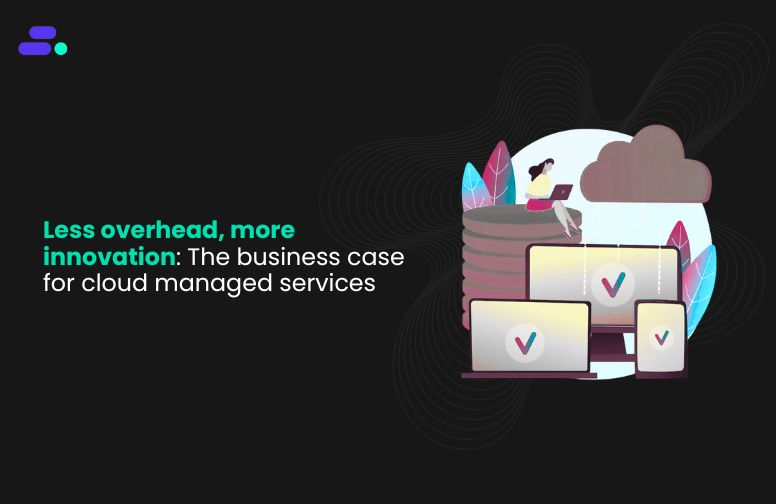
Why are SMBs opting for cloud managed services?
According to Gartner, more than 85% of organizations will have embraced a cloud-first strategy by 2025. But for most of these organizations, especially SMBs, managing cloud infrastructure in-house might feel like trading one set of IT challenges for another. From talent shortages to escalating costs, maintaining secure, scalable environments often stretches lean teams beyond capacity.
That’s why more SMBs are turning to cloud managed services, not just to offload technical work, but to unlock real business agility. The value goes beyond uptime. With 24/7 monitoring, built-in security, and cost-optimized operations, SMBs can shift focus from fire-fighting IT issues to delivering innovation.
This article will dive deeper into the key reasons why SMBs are increasingly choosing managed cloud services over in-house operations.
Key takeaways:
- MSPs simplify cloud complexity: Managed Service Providers handle infrastructure, automation, security, and cost optimization, so SMBs can focus on growth, not IT management.
- They turn cloud into a business advantage: Beyond maintenance, MSPs help SMBs modernize applications, improve performance, and extract more value from AWS investments.
- Cost control is proactive, not reactive: With real-time monitoring, rightsizing, and savings plans, MSPs ensure cloud spending stays aligned with business needs.
- Support is continuous, not just during office hours: MSPs offer 24/7 monitoring, automated incident response, and escalation paths to safeguard critical workloads.
- MSPs are partners in strategy, not just support: The right MSP brings cloud expertise, business alignment, and shared accountability to help SMBs scale with confidence.
How can cloud managed services help SMBs?

Managing cloud infrastructure in-house often becomes a bottleneck for SMBs. Hiring and retaining skilled cloud professionals is costly and time-consuming, and internal IT teams are frequently stretched thin maintaining uptime, updates, and security.
Take the case of a healthcare provider managing its patient data and telemedicine platform on the cloud. While it gives scalability, the in-house IT team is overwhelmed, juggling patch management, uptime monitoring, and security audits, all while lacking deep cloud expertise. Hiring additional DevOps engineers isn't financially viable, and gaps in backup and compliance threaten patient data integrity.
By partnering with a cloud managed service provider (MSP), they can offload day-to-day operations like system monitoring, patching, and security updates. The MSP implements automated backup policies, ensures HIPAA compliance, and introduces 24/7 alerting through AWS-native tools. The result? Improved uptime, faster support response times, and a reduction in operational IT costs.
This shift allows the internal team to refocus on improving the patient experience, rolling out new features and digital services without being slowed down by infrastructure worries.
Key benefits of working with an MSP include:
- Cost savings: Reduce the need for full-time cloud experts, on-prem infrastructure, and ad hoc consulting by shifting to predictable, subscription-based models.
- 24/7 monitoring and support: Ensure round-the-clock availability and fast incident response without the need for internal shift rotations.
- Enhanced security posture: Get continuous vulnerability monitoring, patch management, and compliance reporting, often using AWS-native tools like GuardDuty, CloudTrail, and Config.
- Scalability on demand: Easily scale infrastructure up or down based on real-time business needs, without long procurement cycles.
- Access to cloud expertise: Tap into certified professionals who stay updated with evolving AWS best practices, architectures, and compliance requirements.
Cloud managed services turn reactive IT into a proactive, value-driving function without the burden of building everything in-house.

Top 5 reasons why SMBs choose cloud managed services
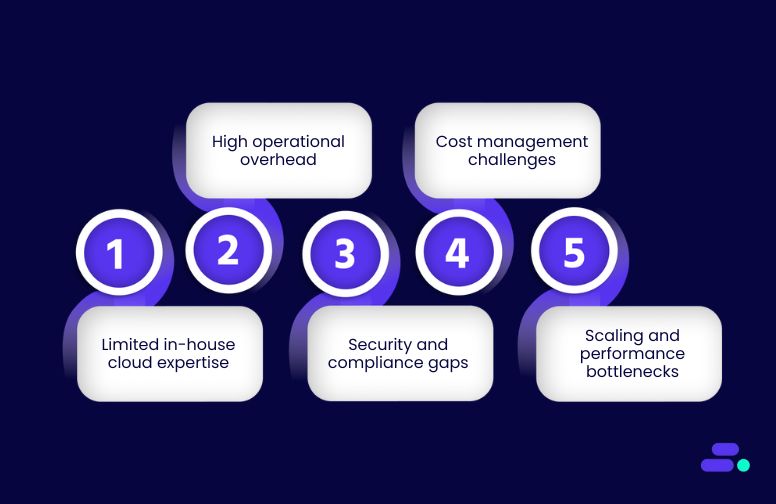
SMBs dealing with limited budgets, human resources shortages, and growing cloud complexity partner with a managed service provider (MSP) for strategic benefits, including enterprise-grade cloud capabilities, proactive support, and operational resilience without the overhead of building internal teams.
There are several reasons why a SMB might choose to work with a MSP. It’s not just about outsourcing IT but unlocking agility, reducing risk, and focusing on growth.
1. Limited in-house cloud expertise
Many SMBs begin their cloud journey without the specialized knowledge required to navigate AWS’s complex ecosystem. Hiring AWS-certified professionals such as cloud architects, DevOps engineers, or security experts is expensive. Attracting and retaining them in a competitive market adds further pressure. For small teams, building in-house capability can take months, delaying key cloud initiatives.
How this impacts business:
- Misconfigurations expose vulnerabilities: Poorly implemented IAM roles, insecure Amazon S3 buckets, or misconfigured VPCs can lead to security incidents or compliance breaches.
- Overprovisioned resources inflate costs: Without deep understanding of AWS pricing models, teams often choose oversized Amazon EC2 instances or underutilize services, leading to significant cost inefficiencies.
- Innovation slows down: Internal teams are pulled into reactive support and troubleshooting, diverting focus from product development and business growth.
MSP Solution: A cloud MSP or an AWS partner brings instant access to AWS-certified experts who apply proven architectural patterns and best practices from the start. They’ll know how to utilize tools like AWS Control Tower for multi-account governance, AWS Well-Architected Framework to identify and fix workload risks, and AWS CloudFormation or Terraform for consistent, repeatable infrastructure deployment. MSPs can also help optimize cost through right-sizing, usage monitoring, and implementation of Savings Plans or Reserved Instances, while ensuring workloads are secure, compliant, and well-architected.
2. High operational overhead
Managing cloud operations, including patching, backups, scaling, monitoring, can quickly overwhelm small IT teams, especially when they’re already juggling daily support, user requests, and legacy infrastructure. As the number of cloud services grows, maintaining performance, reliability, and compliance becomes increasingly complex.
How this impacts business:
- Uptime and performance suffer: Without proactive monitoring and auto-remediation, downtime incidents take longer to detect and resolve, frustrating users and customers.
- Manual monitoring misses critical events: Relying on scripts or ad hoc checks means serious issues like CPU spikes, failed backups, or misbehaving apps can go unnoticed until they cause major disruptions.
- Internal resources are drained: Skilled staff spend time managing maintenance windows, updates, or backup schedules instead of focusing on improving applications or customer experience.
MSP Solution: A cloud MSP or an AWS partner streamlines operational burden by delivering round-the-clock monitoring, automation, and incident management. Using AWS-native tools like Amazon CloudWatch (for real-time performance metrics and alerts), AWS Systems Manager (for fleet-wide automation and patching), and AWS Backup (for centralized backup orchestration), MSPs reduce downtime risks and human error. They implement scaling policies, define runbooks, and proactively manage SLAs, ensuring critical workloads remain available, secure, and performant with minimal internal effort.
3. Security and compliance gaps
SMBs may sometimes lack the tools, time, and expertise required to maintain enterprise-grade cloud security. Implementing continuous monitoring, data encryption, identity access management, and audit readiness across environments demands dedicated effort and specialized skills. For lean IT teams, this might be deprioritized until an incident forces action.
How this impacts business:
- Increased risk of breaches or ransomware: Without intrusion detection, patch management, and network segmentation, attackers can exploit misconfigurations and outdated systems.
- Failure to meet regulatory standards: Regulations like HIPAA, GDPR, or SOC 2 require constant tracking of data handling practices, encryption, and access logs. Failing to do so results in fines and reputational damage.
- Loss of customer trust and legal exposure: A single publicized security incident or compliance violation can erode customer confidence and invite lawsuits or contract cancellations.
MSP Solution: A cloud MSP or an AWS partner provides layered, AWS-native security and governance from day one. They use AWS IAM to enforce least-privilege access, AWS GuardDuty for continuous threat detection, and AWS KMS for encryption key management. AWS Config enables real-time tracking of resource changes and drift from security baselines. MSPs also handle compliance mapping (e.g., to CIS benchmarks or HIPAA frameworks), automate auditing and remediation, and provide ongoing visibility into the security posture through centralized dashboards and alerts, reducing risk without overloading internal teams.

4. Cost management challenges
Cloud services like AWS offer unmatched scalability and pay-as-you-go pricing, but this also means a labyrinth of services, pricing models, and billing intricacies. For SMBs without cloud financial expertise, costs can escalate quickly due to lack of proactive governance, architectural inefficiencies, or simply forgetting to turn things off.
How this impacts business:
- Idle resources and overprovisioning inflate bills: Unused EC2 instances, unattached EBS volumes, or underutilized RDS databases silently accumulate costs every month.
- No visibility means poor forecasting: Without consolidated billing, tagging strategies, or cost anomaly detection, finance teams struggle to track usage or plan budgets effectively.
- Inefficient architecture increases long-term TCO: Choosing the wrong storage class (e.g., using Amazon S3 Standard when Infrequent Access would suffice) or not using auto-scaling can lead to high operational overhead.
MSP Solution: A Cloud MSP or an AWS partner helps SMBs establish financial discipline on AWS from day one. They set up detailed tagging policies, budgets, and alerts using AWS Budgets, Cost Explorer, and AWS Cost Anomaly Detection. MSPs also implement architectural optimizations. This includes auto-scaling groups, rightsizing recommendations, and Amazon S3 lifecycle policies to match consumption to actual demand. They review architecture regularly and guide adoption of Savings Plans, Reserved Instances, or spot instances where appropriate, aligning cloud spend with business value and preventing bill shock.
5. Scaling and performance bottlenecks
As an SMB’s user base grows or application workloads increase, their cloud infrastructure must scale seamlessly to maintain performance and reliability. However, designing for elasticity, managing service quotas, and ensuring availability across regions or Availability Zones (AZs) is complex. Without proactive planning, systems become vulnerable to traffic spikes or component failures.
How this impacts business:
- Downtime or degraded performance during peak loads: Inability to handle traffic surges can crash applications or lead to sluggish experiences.
- Loss of revenue and brand reputation: Users expect responsive services; delays or outages can result in churn, cart abandonment, or lost transactions.
- Reactive scaling leads to inefficiencies: Without automated scaling or forecasting, teams scramble to provision resources manually, often too late or too expensively.
MSP Solution: Cloud MSPs and AWS partners design infrastructure with scalability and resilience at the core. They implement AWS Auto Scaling, Elastic Load Balancing (ELB), and Amazon EC2 Spot Fleets to adjust capacity dynamically based on demand. To ensure high availability, MSPs distribute workloads across multiple Availability Zones and architect for fault tolerance using services like Amazon Route 53, Amazon RDS Multi-AZ, and Amazon S3 cross-region replication.
They also use tools like AWS Fault Injection Simulator and Amazon CloudWatch Synthetics to simulate failures and proactively identify bottlenecks, ensuring the system performs reliably under pressure and scales as the business grows.

Why should SMBs choose Cloudtech as their AWS partner?
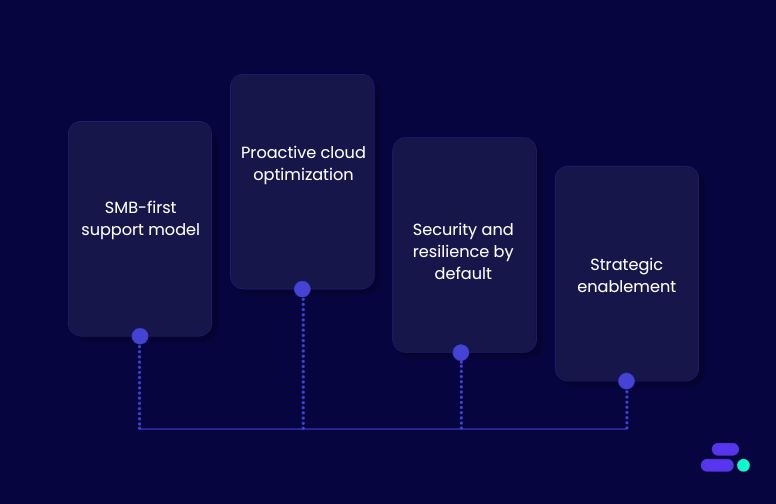
Behind every resilient, cost-efficient cloud operation is a partner who not only knows AWS, but knows how small and mid-sized businesses work. Cloudtech, an AWS Advanced Tier Services Partner focused exclusively on SMBs, delivers managed cloud services that go beyond maintenance. It helps companies scale with confidence, operate securely, and stay focused on what they do best.
Here’s how Cloudtech stands out as a Managed Service Provider for SMBs on AWS:
- SMB-first support model: 24/7 monitoring, incident response, and patch automation designed for lean teams, without bloated contracts or vendor lock-in.
- Proactive cloud optimization: Continuous performance, cost, and security tuning using AWS-native tools like Amazon CloudWatch, Trusted Advisor, and Config.
- Security and resilience by default: Built-in multi-AZ architecture, automated backups, IAM best practices, and GuardDuty for always-on protection.
- Strategic enablement: Cloudtech goes beyond ticket handling, delivering hands-on guidance, cost control, and knowledge transfer to help SMBs scale with confidence.
With a strong track record of helping small and mid-sized businesses succeed on AWS, Cloudtech brings enterprise-grade expertise with SMB-aligned execution. That means faster outcomes, clearer ROI, and a partner that grows with the business.
See how other SMBs have modernized, scaled, and thrived with Cloudtech’s support →

Wrapping up
Managing cloud environments in-house often means choosing between focus and fire drills. That’s why having the right AWS partner makes all the difference, not just by keeping systems running, but by driving smarter operations, lower costs, and faster innovation.
What makes Cloudtech different is its SMB-first approach to managed services. It is proactive, cost-aware, and aligned to business goals. With deep AWS expertise and a track record of success, they don’t just support cloud transition, they help SMBs thrive on it.
Ready to simplify operations and scale with confidence? Discover how Cloudtech’s managed services can power your next phase of growth.
FAQs
1. How is Cloudtech different from a traditional managed service provider (MSP)?
Unlike traditional MSPs that focus on legacy infrastructure and ticket-based support, Cloudtech is a cloud-native AWS Advanced Tier Partner. Their model emphasizes automation, scalability, and continuous improvement. Cloudtech’s team designs and manages environments using AWS best practices, including auto-scaling, serverless orchestration, and proactive monitoring, enabling SMBs to move faster, stay secure, and evolve continuously without being held back by legacy IT processes.
2. Is managed cloud support from Cloudtech affordable for small and mid-sized businesses?
Yes. Cloudtech’s services are built specifically for SMBs and are designed to be cost-effective without compromising quality. Instead of one-size-fits-all contracts, they offer flexible, outcome-based support tiers. Clients only pay for what they need, resulting in better ROI, reduced cloud waste, and faster access to cloud benefits.
3. What kind of support does Cloudtech offer outside regular working hours?
Cloudtech offers proactive 24/7 cloud monitoring and alerting for critical workloads as part of its managed services model. Using AWS-native tools like Amazon CloudWatch, AWS Config, and CloudTrail, the Cloudtech team ensures that infrastructure performance, availability, and security are continuously tracked, even outside standard business hours. While real-time issue detection is automated, any critical incidents are escalated based on agreed SLAs. For SMBs without in-house night or weekend coverage, this provides confidence that their environments are being actively observed, even when their team is offline.
4. How does Cloudtech help optimize and control AWS costs over time?
Cloudtech takes a proactive approach to cloud cost management. Their team continuously monitors usage with AWS Cost Explorer, Trusted Advisor, and CloudWatch metrics, identifying opportunities to rightsize infrastructure, reduce waste, and apply appropriate pricing models like Savings Plans and Reserved Instances. By aligning spend with business goals, Cloudtech ensures SMBs stay lean, predictable, and financially efficient on AWS.
5. Will SMBs still retain control and visibility over their AWS environment with Cloudtech?
Absolutely. Cloudtech promotes a shared ownership model. Clients retain full access, visibility, and governance over their AWS accounts. As part of every engagement, Cloudtech provides clear documentation, monitoring dashboards, and knowledge transfer to ensure internal teams are empowered, not sidelined. Their goal is to enhance the client’s capabilities, not replace them, offering expert guidance while keeping businesses in the driver’s seat.
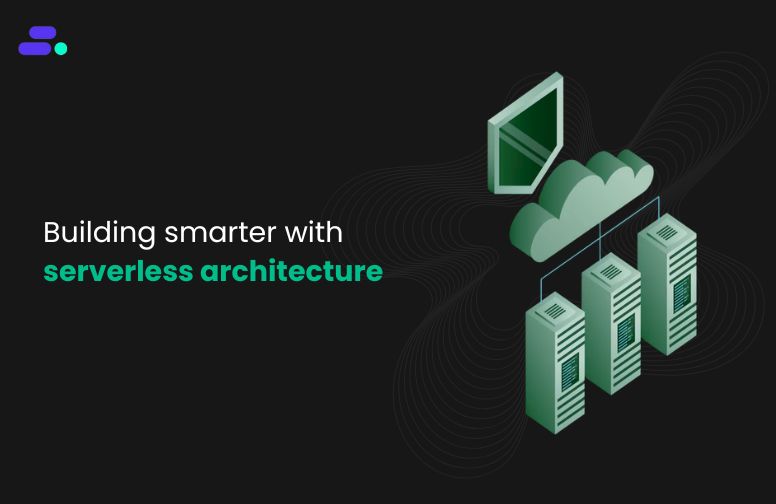
Demystifying serverless: How do modern apps run without servers?
Serverless architecture is a cloud-native model where developers build and run applications without managing servers. Instead of provisioning or maintaining infrastructure, services like AWS Lambda automatically execute code in response to events and scale based on real-time demand. This frees up time and resources, making it especially valuable for small and medium-sized businesses (SMBs).
For example, a healthcare SMB can use AWS Lambda, API Gateway, and Amazon S3 to build a serverless patient intake system that handles forms, stores records, and sends notifications, without managing servers. This cuts infrastructure costs by over 60%, boosts data availability, and simplifies HIPAA compliance, letting teams focus on care, not maintenance.
This article walks through the fundamentals behind serverless architecture, the AWS services enabling it, and how it empowers SMBs to innovate efficiently and securely.
Key takeaways:
- Serverless cloud computing runs code on AWS with no servers to manage, billing only for actual execution.
- Core stack: event‑driven functions (FaaS), managed back‑end services (BaaS), and auto‑scaling data pipelines that link front‑end and back‑end.
- Best suited to bursty or asynchronous workloads like APIs, ETL, real‑time analytics, and IoT, where SMBs need quick releases and minimal ops overhead.
- Key trade‑offs like cold‑start delays, runtime limits, monitoring complexity, and potential vendor lock‑in are mitigated by least‑privilege IAM, encrypted data, and robust observability.
- Cloudtech guides SMBs through a five‑phase AWS roadmap, delivering secure pipelines, compliant data lakes, and GenAI‑ready foundations.
How does serverless architecture work? A simple breakdown
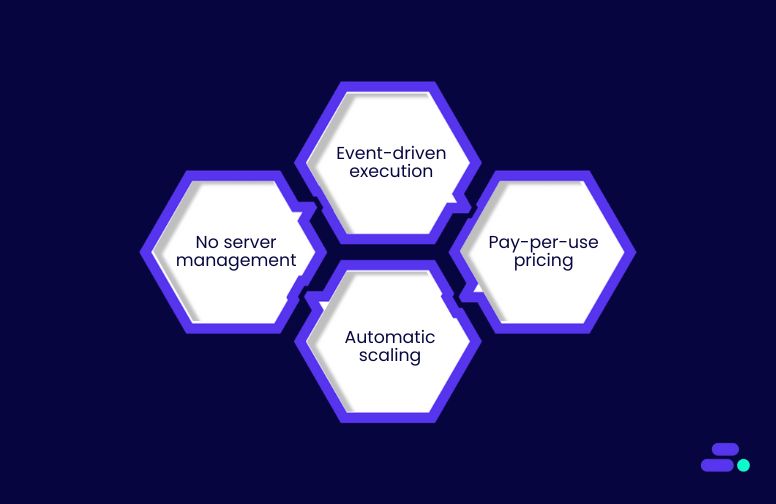
Serverless architecture is a cloud-native model where the cloud provider (like AWS) automatically manages the infrastructure. Instead of provisioning servers, scaling compute, or handling maintenance tasks, developers simply write and deploy code. Serverless apps are built to run inside short-lived, stateless containers such as AWS Lambda, which are triggered by specific events and shut down after execution.
Unlike traditional apps that run continuously, serverless apps execute only when needed, like when a user makes a request or a file is uploaded. This event-driven, on-demand execution model helps SMBs stay lean and agile, eliminating idle resource costs and manual scaling.
The key characteristics of serverless apps include:
- No server management: All infrastructure is managed by the cloud provider
- Event-driven execution: Code runs only in response to specific triggers
- Automatic scaling: Resources scale up or down with workload changes
- Pay-per-use pricing: SMBs charged only for actual compute time used
This model significantly benefits SMBs by speeding up development, reducing operational burden, and aligning cloud costs directly with usage.
Serverless also simplifies how frontends and backends interact. Web and mobile apps can invoke backend functions directly through services like Amazon API Gateway, enabling real-time communication without the need for persistent server infrastructure. These backend functions, running on AWS Lambda, can process data, call APIs, or store outputs in services like Amazon S3 or DynamoDB, all without manual scaling or server setup.
There are multiple types of serverless computing that serve different layers of the application stack. Each plays a distinct role in simplifying development and reducing infrastructure management:
- Function-as-a-Service (FaaS): Runs discrete, event-driven functions without persistent infrastructure. (e.g., AWS Lambda)
- Backend-as-a-Service (BaaS): Offers managed services for common backend needs like auth, storage, and databases. (e.g., Amazon Cognito, AWS Amplify)
- Serverless databases: Scale automatically and require no server maintenance. (e.g., Amazon DynamoDB, Aurora Serverless)
- Serverless containers: Containers that run and scale without manual provisioning. (e.g., AWS Fargate)
- Serverless edge computing: Executes functions closer to users to reduce latency. (e.g., AWS Lambda@Edge)
To see where FaaS fits within the broader cloud landscape, it helps to compare it with other service models. FaaS offers maximum abstraction, where developers write only the function logic, and the cloud handles the rest. Other models offer varying levels of control and responsibility:
Combining the right serverless components allows SMBs to reduce complexity, scale on demand, and build modern applications faster, all while keeping costs predictable and operations lightweight.

How can SMBs run applications on serverless architecture?
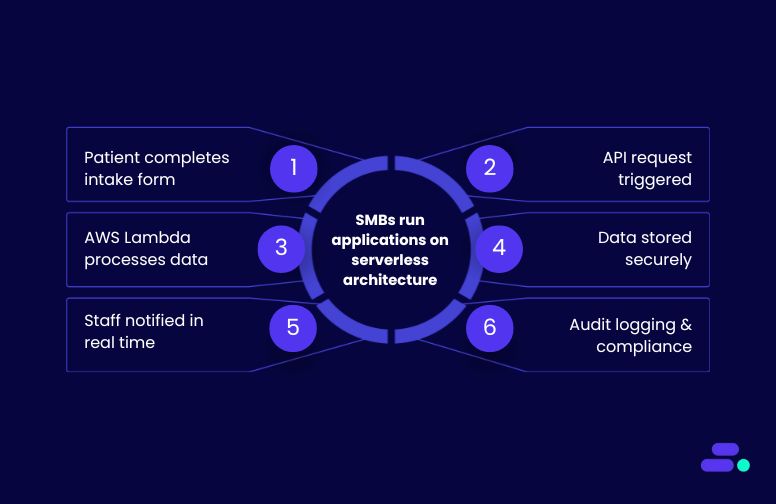
Serverless apps run in response to events, like form submissions or file uploads, using managed cloud services. Instead of operating on always-on servers, each component executes on demand, scales automatically, and requires no infrastructure management. Services like AWS Lambda, API Gateway, and DynamoDB handle compute, APIs, and data, so developers can focus on functionality, not infrastructure.
Consider a healthcare SMB modernizing its patient intake process. Using AWS serverless tools, it builds an app that collects patient data online, validates it, stores it securely, notifies staff in real time, and logs activity for compliance, all without managing a single server.
Step 1: Patient fills out the online intake form
The journey begins when a patient opens the clinic’s website or mobile app to complete a digital intake form. The form collects essential details like name, symptoms, insurance info, and optional document uploads.
The frontend of the application is serverless and static, hosted on:
- AWS Amplify for rapid development and deployment of web/mobile apps
- Or Amazon S3 with CloudFront for secure, low-latency static hosting
All content is served via a global CDN, ensuring speed and availability across regions. The serverless frontend allows instant scaling and simplified deployment without maintaining web servers.
Step 2: Form submission triggers an API request
When the patient submits the form, the data is sent to the backend using HTTPS. But instead of routing to a traditional server, the request is handled by a serverless API endpoint.
Amazon API Gateway acts as the secure entry point:
- It accepts, validates, and routes incoming API calls
- It supports throttling, authentication (e.g., via Amazon Cognito), and monitoring
- It integrates directly with AWS Lambda without requiring server infrastructure
API Gateway offloads the complexity of managing and securing APIs, helping SMBs launch secure backends faster.
Step 3: AWS Lambda processes the incoming data
The API call triggers a Lambda function, which contains the core logic for processing the patient submission. The function performs multiple tasks in milliseconds:
- Validates input (e.g., required fields, data types, document size)
- Performs lightweight logic (e.g., checking symptom severity, tagging high-priority cases)
- Formats data for storage or additional processing
- Lambda runs in an isolated, ephemeral container, spinning up only when triggered and shutting down after execution
- It scales automatically per request, ensuring zero performance lag under load
Lambda allows SMBs to run secure, scalable backend logic without provisioning compute infrastructure.
Step 4: Data is stored in secure, scalable storage
Once validated, patient information and documents need to be stored securely for later retrieval and processing.
Amazon DynamoDB is used for storing structured data:
- Patient name, symptoms, contact info, and form metadata
- Fast, scalable NoSQL database with automatic scaling and low-latency performance
- Supports fine-grained access control and encryption at rest
Amazon S3 stores unstructured data like:
- Uploaded documents (insurance cards, test results)
- Each file can be encrypted using SSE-S3 or SSE-KMS for HIPAA-compliant storage
These services offer scalable, pay-as-you-go storage that complies with healthcare data regulations and eliminates the need for physical servers or database licenses.
Step 5: Clinic staff is notified in real time
Once the form is submitted and data is stored, the system triggers a notification to the clinic’s admin or triage team.
A second Lambda function or AWS Step Functions orchestrates the post-submission flow:
- Determines priority based on patient symptoms
- Sends alerts via Amazon SNS (email or SMS) or posts to a Slack channel
- Optionally logs an entry into a clinic-facing dashboard using a service like Amazon AppSync (GraphQL-based real-time API)
Real-time communication ensures clinics can act on urgent cases immediately, improving patient outcomes and operational efficiency.
Step 6: Audit logging and compliance
Every API call, function execution, and data access is logged for auditing and compliance, which is crucial in healthcare where regulations like HIPAA require full traceability.
Amazon CloudWatch captures:
- Lambda invocation logs, function errors, and performance metrics
- Alarms can be set for anomalies or failures
AWS CloudTrail tracks:
- API Gateway calls
- IAM usage and access events
- Data changes or actions performed by clinic staff or applications
Built-in logging and audit trails help SMBs meet regulatory obligations without building custom monitoring systems.
By using AWS serverless tools, the healthcare SMB builds a scalable, secure, and event-driven patient intake system that:
- Launches faster than traditional web apps
- Costs less to run and maintain
- Automatically adapts to traffic spikes (e.g., flu season or viral outbreak)
- Provides a seamless, responsive experience for patients
- Keeps operations compliant without a dedicated DevOps team
This allows them to outpace competitors who are stuck in legacy hosting models, enabling rapid innovation, real-time care delivery, and higher patient satisfaction.
Also Read: Building Modern Data Streaming Architecture on AWS
5 ways serverless helps SMBs outpace competitors
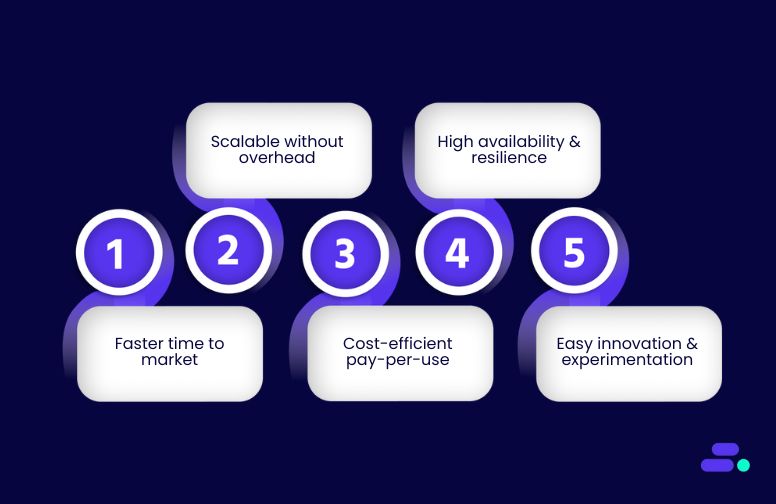
SMBs can’t afford to be slowed down by traditional infrastructure models. Serverless architecture offers them a strategic edge, leveling the playing field with enterprise-grade scalability, agility, and efficiency, all without the heavy investment.
Serverless architecture helps SMBs move faster, do more with less, and stay ahead of the competition.
1. Accelerated time to market
Serverless allows developers to focus entirely on business logic rather than infrastructure. With services like AWS Lambda, teams can deploy new features or entire services in hours instead of weeks. This agility is critical when competing against larger players with more resources.
For example, a regional e-commerce SMB uses AWS Lambda and Amazon API Gateway to roll out flash-sale features during festive seasons. Because there’s no infrastructure setup delay, the business can respond to market trends and customer demands within days, gaining a first-mover advantage in local markets.
2. Enterprise-grade scalability without the overhead
Serverless architectures scale automatically with user demand. Whether it’s ten users or ten thousand, services like AWS Lambda, Amazon DynamoDB, and Amazon S3 adjust instantly without needing manual provisioning or load balancer configuration.
For example, a telehealth startup built its appointment and consultation app using AWS Lambda and Amazon DynamoDB. During a sudden spike in demand (e.g., a local flu outbreak), the system scaled automatically to handle thousands of concurrent users, without performance dips or IT intervention.
3. Radical cost efficiency with pay-per-use
SMBs often struggle with budget constraints. Serverless removes the need for idle infrastructure spend. Businesses only pay for what they use. Every millisecond of execution is billed, not the time the server sits idle.
For example, a bootstrapped fintech firm replaces its legacy backend with AWS Lambda-based microservices. Instead of paying for always-on servers, it now only incurs charges when functions are triggered. This can be during customer logins, transactions, or report generation. This shift cuts monthly infrastructure costs by over 65%, allowing funds to be reinvested in product development.
4. Built-in high availability and resilience
Serverless apps automatically inherit the availability and fault-tolerance of the cloud platform. AWS services distribute functions across multiple availability zones, reducing the risk of downtime or single points of failure.
For example, a digital document management SMB serving law firms builds its workflow engine using AWS Lambda, Step Functions, and S3. Even during regional outages or traffic surges, the system continues operating smoothly, ensuring clients can access time-sensitive documents without interruption, an advantage over competitors with legacy on-prem systems.
5. Frictionless innovation and experimentation
Serverless lowers the barrier to trying new ideas. There’s no upfront infrastructure cost, no long deployment cycles, and failures don’t tie up resources. Teams can run experiments, A/B tests, or new services quickly and kill them just as easily if they don’t work.
For example, a media startup experiments with a personalized recommendation engine using AWS Lambda, Amazon Personalize, and Amazon API Gateway. The team deploys it to a small user group, tests engagement, and iterates based on real-time feedback. Because it’s serverless, there’s no infrastructure lock-in or cost risk, unlike competitors who need months of planning before launching similar features.

To fully realize the benefits of serverless architecture, SMBs need more than just cloud tools. They need a clear strategy and experienced guidance. That’s where Cloudtech comes in.
How does Cloudtech support secure serverless data modernization?
For SMBs adopting serverless cloud computing, success depends on both secure workloads and a modern data foundation. Cloudtech combines these with AWS-native solutions designed for scale, speed, and compliance.
- Streamlined, secure data pipelines: Cloudtech designs event-driven data pipelines using AWS Lambda, Glue, and Kinesis, enabling real-time processing without server management. These architectures are built with security-first principles, including role-based access and audit logging.
- Scalable storage and analytics: Using Amazon S3, Redshift, and Aurora, Cloudtech creates data lakes and warehouses that handle growth, concurrency, and cost-efficiency, crucial for SMBs scaling up without infrastructure overhead.
- Compliance-ready by design: Whether it’s HIPAA, FINRA, or internal governance, Cloudtech ensures data architectures meet regulatory requirements through native AWS tools like CloudTrail, AWS Config, and IAM.
- GenAI-ready architecture: Cloudtech prepares data environments for future generative AI use cases, ensuring clean, structured inputs and scalable backend support.
- Human-centric implementation model: Through a five-stage process—Engage, Discover, Align, Deliver, Enable—Cloudtech tailors modernization strategies to each SMB’s goals, ensuring long-term security, usability, and performance.
This approach ensures that SMBs not only adopt serverless securely but also build a data infrastructure that supports ongoing innovation and growth.

Conclusion
For SMBs, embracing serverless architecture is a strategic move toward speed, efficiency, and long-term agility. By removing the burden of infrastructure management, serverless frees up teams to focus on what truly matters: building great products, responding to customers faster, and scaling without friction.
But realizing this potential requires more than just picking the right AWS services, it takes the right approach. That’s where Cloudtech helps SMBs move from complex, costly on-prem systems to streamlined, serverless environments that support faster innovation, lower overhead, and lasting competitive advantage.
If your business is ready to modernize and move faster, serverless is the smarter path forward—and Cloudtech is here to help you take it. Connect today with Cloudtech!
FAQs
1. Is serverless cloud computing a good fit for growing SMBs?
es. Serverless is ideal for SMBs that want to scale efficiently without managing infrastructure. It offers automatic scaling, high availability, and pay-as-you-go pricing, making it a smart option for businesses with evolving workloads and limited IT resources.
2. Can serverless be used in compliance-heavy industries like healthcare or finance?
Absolutely. When configured properly, AWS serverless services support industry regulations such as HIPAA, FINRA, and GDPR. Built-in tools like AWS IAM for access control, AWS CloudTrail for auditing, and AWS Config for compliance tracking help ensure secure and standards-aligned deployments.
3. Can serverless integrate with existing legacy systems?
Yes. Serverless functions can be triggered via APIs, queues, or event streams, making them compatible with most legacy environments. This allows businesses to gradually modernize without disrupting existing systems or workflows.
4. How does serverless affect cloud costs for SMBs?
Serverless pricing is based on actual usage, which can significantly reduce costs for applications with intermittent or unpredictable demand. However, for consistently high workloads, other models may be more cost-effective. The key is choosing serverless where it offers the most operational and financial value.
5. What kind of support does Cloudtech provide throughout the serverless transition?
Cloudtech offers end-to-end support, from initial AWS assessments to designing, deploying, and optimizing serverless applications. Their certified architects help SMBs build secure, scalable systems and provide training, documentation, and long-term support to ensure ongoing success.
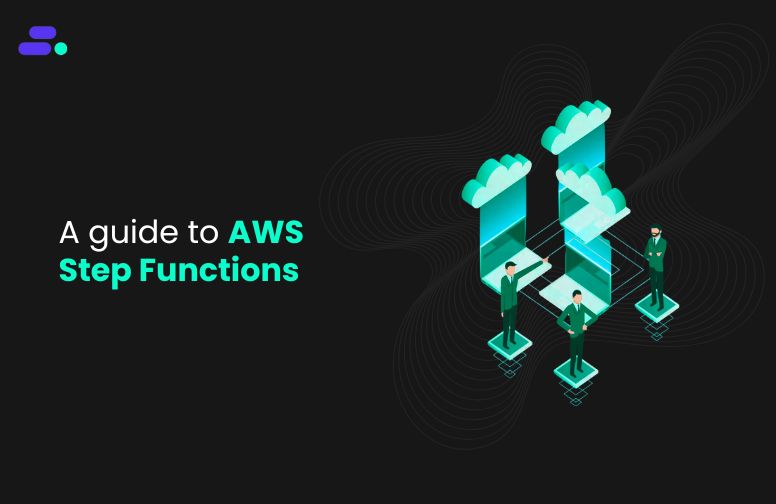
AWS Step Functions explained: A complete implementation guide
Managing complex workflows across multiple AWS services can be difficult to scale and maintain. AWS Step Functions solves this by providing a serverless workflow engine that coordinates tasks into defined, reliable sequences without requiring custom orchestration logic.
For example, a healthcare SMB automating patient onboarding can use Step Functions to chain together Lambda functions for data validation, store records in DynamoDB, run a background verification via API Gateway, and send confirmation emails. They can do all this in a single visual workflow with built-in error handling and retries.
This guide explains how AWS Step Functions work, how to implement them with best practices, and how small and mid-sized businesses can use them to improve automation, reduce complexity, and move faster without sacrificing control.
Key takeaways:
- Step Functions simplify orchestration: They coordinate services like Lambda, S3, Glue, and DynamoDB into reliable, visual workflows, eliminating the need for custom orchestration code.
- Built for complex, scalable automation: Supports both long-running and high-throughput workflows with features like retries, branching, and parallel execution, ideal for modern backend systems.
- Real-world use cases are production-ready: Examples include ETL pipelines, event-driven file processing, multi-branch data merges, and human-in-the-loop approvals, built using actual SMB patterns.
- Deep AWS integration is a core strength: It smoothly integrates with over 220 AWS services, including Amazon Redshift, SNS/SQS, CloudWatch, and RDS, thereby reducing infrastructure overhead and improving consistency.
- Monitoring and debugging are built in: With CloudWatch and X-Ray, teams gain full visibility into the execution flow, performance issues, and error traces, critical for achieving operational excellence.
What is AWS Step Functions?
AWS Step Functions is a fully managed orchestration service that simplifies how teams coordinate distributed workflows across AWS. It utilizes Amazon States Language (ASL) to define processes as state machines, which are JSON-based workflows that link services such as Lambda, S3, DynamoDB, and others.
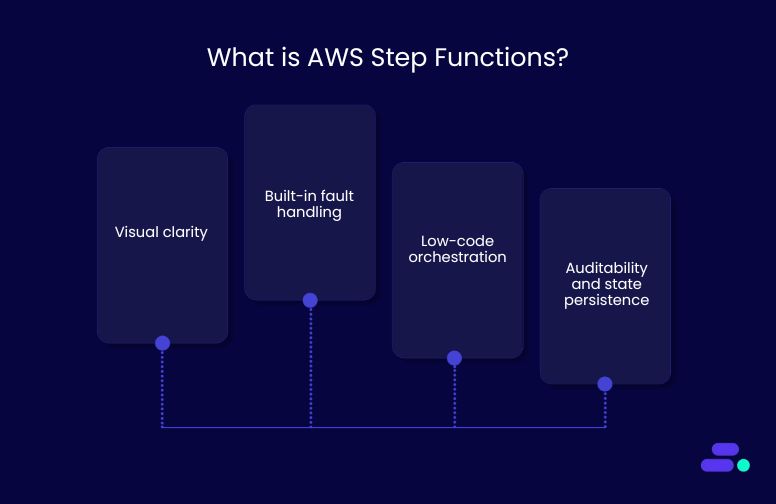
Step Functions brings several advantages to cloud-native architectures:
- Visual clarity: Workflows are represented as state diagrams, making logic easier to understand and debug.
- Built-in fault handling: Automatic retries, catch blocks, and state tracking ensure workflows are resilient to failures.
- Low-code orchestration: Developers focus on business logic while Step Functions handles flow control, error handling, and sequencing.
- Auditability and state persistence: Long-running workflows can pause and resume, while all execution history is recorded for traceability.
The service integrates natively with over 220 AWS services, including Amazon ECS, SageMaker, AWS Glue, and Athena. These native integrations simplify operations such as passing data between services, managing retries and exceptions, and handling authentication, all without custom glue code.
Whether coordinating high-volume data processing tasks or managing approval flows in business processes, Step Functions offers a scalable, reliable foundation for building event-driven and serverless applications on AWS.

Implementing AWS Step Functions: a step-by-step guide
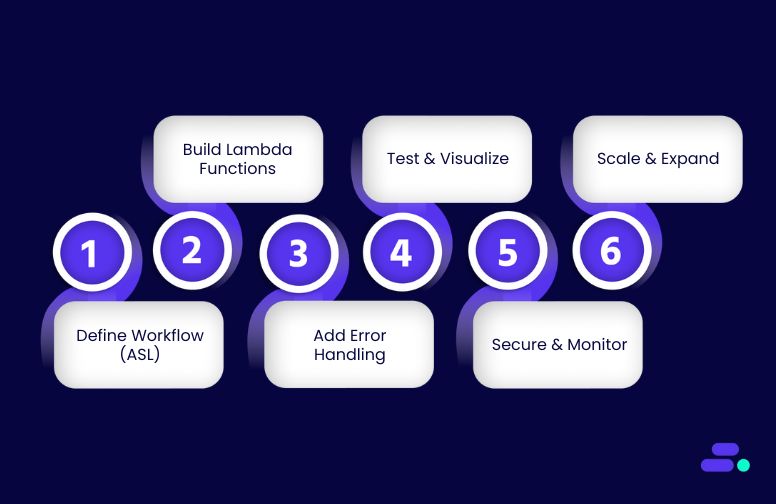
For SMBs looking to automate processes without overcomplicating infrastructure, AWS Step Functions offers a practical and scalable solution. This service helps coordinate tasks across AWS, allowing technical teams to focus on business value instead of operational plumbing.
To understand how it works, consider a familiar scenario of a healthcare center automating a patient intake and scheduling workflow using AWS Step Functions. The workflow includes:
- Accept patient registration
- Verify insurance details
- Check provider availability
- Schedule appointment
- Send a confirmation email
Each step is orchestrated by AWS Step Functions, using services like AWS Lambda, Amazon DynamoDB, and Amazon SES.
Step 1: Define the workflow using Amazon States Language (ASL)
The first step is defining a state machine using Amazon States Language (ASL). Each “state” maps to a task in the intake process.
Example ASL definition:
{
"StartAt": "VerifyInsurance",
"States": {
"VerifyInsurance": {
"Type": "Task",
"Resource": "arn:aws:lambda:region:acct:function:VerifyInsurance",
"Next": "CheckAvailability"
},
"CheckAvailability": {
"Type": "Task",
"Resource": "arn:aws:lambda:region:acct:function:CheckAvailability",
"Next": "ScheduleAppointment"
},
"ScheduleAppointment": {
"Type": "Task",
"Resource": "arn:aws:lambda:region:acct:function:ScheduleAppointment",
"Next": "SendConfirmation"
},
"SendConfirmation": {
"Type": "Task",
"Resource": "arn:aws:lambda:region:acct:function:SendEmail",
"End": true
}
}
}What this code does: This JSON defines an AWS Step Functions state machine that automates a patient appointment workflow. It specifies a sequence of tasks, each linked to an AWS Lambda function:
- StartAt: "VerifyInsurance": The workflow begins by verifying the patient’s insurance.
- "VerifyInsurance": Calls a Lambda function to validate insurance, then moves to check provider availability.
- "CheckAvailability": Queries available appointment slots.
- "ScheduleAppointment": Books the appointment in the system.
- "SendConfirmation": Sends a confirmation email to the patient and ends the workflow.
Each state is a step in the process, and the Next or End fields control the execution flow. This enables a fully automated, fault-tolerant healthcare intake process.
Step 2: Build the supporting AWS Lambda functions
Once the workflow is defined in Step Functions, each state must be backed by a purpose-built AWS Lambda function that executes a specific task in the sequence. These functions contain the actual business logic, whether it’s checking insurance, querying appointment slots, or sending emails. They are triggered automatically as the state machine progresses.
Each function should be:
- Modular and independently testable
- Scoped with minimal IAM permissions
- Configured with timeouts and retries based on expected SLA
This separation of concerns ensures each task is easy to manage, secure, and scalable, allowing healthcare teams to update or extend individual steps without disrupting the entire process.
Example Lambda (Node.js) for insurance verification:
exports.handler = async (event) => {
const isValid = await checkInsuranceAPI(event.insuranceId);
if (!isValid) throw new Error("Insurance verification failed");
return { status: "verified" };
};Here:
- event.insuranceId: Receives the insurance ID from the Step Functions input.
- checkInsuranceAPI(...): Calls an asynchronous function to verify insurance status with an external system.
- Error Handling: If the insurance is not valid, the function throws an error. Step Functions can catch this and route to an error state.
- Return: If the insurance is verified, it returns a success status for the next step in the workflow.
This function typically powers the VerifyInsurance state in a healthcare appointment scheduling workflow.
Step 3: Add error handling and retries
Healthcare workflows require fault tolerance. Step Functions provides native retry and catch mechanisms.
Example retry config for insurance check:
"VerifyInsurance": {
"Type": "Task",
"Resource": "arn:aws:lambda:...:VerifyInsurance",
"Retry": [
{
"ErrorEquals": ["Lambda.ServiceException"],
"IntervalSeconds": 5,
"MaxAttempts": 3
}
],
"Catch": [
{
"ErrorEquals": ["States.ALL"],
"Next": "LogFailure"
}
],
"Next": "CheckAvailability"
}Here:
- Type: "Task": This is a state that runs a task. In this case, a Lambda function.
- Resource: The ARN of the Lambda function VerifyInsurance, which handles insurance validation.
- Retry block: Retries up to 3 times if the Lambda returns a Lambda.ServiceException (a common transient error). Waits 5 seconds between each retry.
- Catch block: Catches all types of errors (States.ALL) if retries fail. Redirects the flow to a fallback state called LogFailure, which could handle logging, alerting, or compensation.
- Next: If the Lambda succeeds, the flow continues to CheckAvailability.
This setup ensures resilience and error visibility. If the insurance verification step temporarily fails (e.g., due to network latency), retries handle it automatically. If the failure is persistent, it is safely caught and redirected, preventing silent workflow failures.
Step 4: Visualize and test the workflow
Once the state machine is defined and deployed, the AWS Step Functions visual workflow console provides a clear, interactive way to test and monitor it, making it valuable for both technical and non-technical stakeholders.
The visual interface shows the full execution path of the workflow, step by step. This allows teams to see how data moves, where errors may occur, and what the outputs are at each stage. It also helps stakeholders like clinic administrators understand and verify the business logic before deploying to production.
Key benefits of the visual console:
- Real-time execution tracking: Each state is highlighted as it executes, providing instant visibility into progress and outcomes.
- Step-level inspection: Click into each state to view input/output data, runtime metrics, and any errors, ideal for debugging.
- Test case simulation: Teams can run test inputs (e.g., invalid insurance ID, unavailable appointment slots) to validate error handling and fallback logic.
- Cross-functional clarity: Non-developers can follow the workflow visually, making collaboration across technical and business teams easier.
This step ensures the workflow is functioning as intended, reduces the risk of bugs post-deployment, and builds team confidence in the automation.
Step 5: Secure and monitor the workflow
In healthcare scenarios, especially those involving sensitive patient data, security and observability are non-negotiable. AWS Step Functions, combined with supporting AWS services, allows SMBs to build workflows that are secure, compliant (e.g., with HIPAA), and fully traceable.
To ensure that every step of the workflow is both protected and observable, it’s important to implement the following:
Security best practices:
- Use least-privilege IAM roles: Assign narrowly scoped roles to each Lambda function and the Step Function itself. This limits what resources each service can access, minimizing risk if credentials are compromised.
- Encrypt environment variables and outputs: Ensure sensitive data (like patient IDs or insurance info) is encrypted in transit and at rest using AWS KMS.
Monitoring and observability:
- Enable CloudWatch Logs: Log all execution data, including inputs, outputs, errors, and durations. These logs are essential for debugging and post-incident analysis.
- Set CloudWatch Alarms: Trigger alerts for failed states, such as an unverified insurance policy or a scheduling failure, so the ops team can respond immediately.
- Enable AWS X-Ray (optional): For more complex workflows, X-Ray traces end-to-end execution across services like Lambda, API Gateway, or DynamoDB, helping diagnose latency and bottlenecks.
By integrating these tools, SMBs get enterprise-grade monitoring and security without needing costly third-party solutions. This foundation supports both trust and reliability in healthcare workflows.
Step 6: Scale and expand
As the healthcare SMB grows, adding new providers, locations, or services, the appointment scheduling workflow must evolve to handle increased complexity without creating new technical debt. AWS Step Functions is designed with modularity and scalability in mind, allowing teams to enhance their workflows incrementally.
Ways to expand the workflow:
- Parallel states: Support multiple provider checks at the same time (e.g., when a patient can see any available doctor across departments).
- Choice states: Route logic based on insurance type, appointment urgency, or patient age group. For example, directing pediatric appointments to specific providers.
- Map states: Handle batch processes like sending follow-up reminders for multiple patients, processing appointment cancellations in bulk, or reconfirming bookings.
Why this matters: Step Functions allows SMBs to scale without rewrites. As regulations, services, or team sizes change, businesses can plug in new functionality with minimal disruption. This adaptability is especially valuable in healthcare, where patient care, compliance, and system reliability must go hand in hand.
Final outcome: What does the SMB get out of AWS Step Functions?
Using AWS Step Functions to automate appointment scheduling allows the healthcare SMB to transform a fragmented intake process into a coordinated, reliable workflow. The result is:
- Streamlined operations: Tasks like insurance checks, scheduling, and notifications run seamlessly without manual coordination.
- Faster patient onboarding: Real-time validation and booking reduce delays for both patients and staff.
- Lower operational overhead: Staff spend less time chasing paperwork or managing schedules, freeing up time for patient-facing activities.
- Built-in adaptability: New services, insurers, or routing rules can be added with minimal changes to existing logic.
The overall impact is greater efficiency, fewer errors, and a foundation that supports both patient satisfaction and long-term business growth.

AWS Step Functions: popular use cases and examples
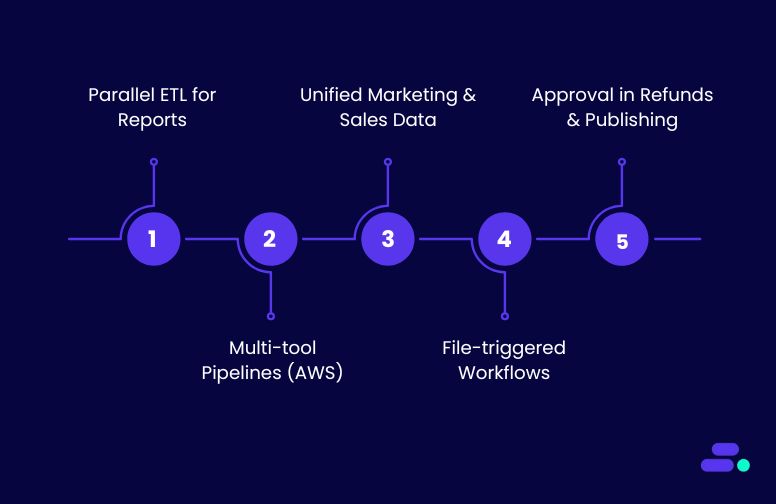
SMBs with limited DevOps resources but growing backend complexity, such as healthcare providers, fintech startups, SaaS vendors, and e-commerce businesses, benefit most from AWS Step Functions. These organizations need to automate multi-step processes like appointment scheduling, transaction validation, or order fulfillment across several AWS services without building and maintaining brittle glue code.
Built-in retries, state tracking, and visual debugging make it easier to deliver consistent outcomes, handle failures gracefully, and meet compliance or SLA requirements. With AWS Step Functions, SMBs can implement resilient, observable workflows with minimal operational overhead.
1. Parallel ETL processing for daily business reports
The challenge: A retail SMB needed to process product, transaction, and user data nightly for business dashboards. Running ETL tasks one after another created delays and missed report deadlines.
How AWS Step Functions helped: Using a Parallel state, AWS Step Functions ran three AWS Glue jobs simultaneously:
- Product data was validated and standardized.
- Transactions were deduplicated and enriched.
- User logs were normalized by timestamp.
If any job failed, the error was logged in AWS DynamoDB, and an alert was sent through Amazon SNS. Successful outputs were merged and loaded into Amazon Redshift.
Outcome: Faster pipeline execution, reduced latency, and consistent daily insights, all without manual coordination.
2. Multi-tool data pipelines using AWS
The challenge: A fintech client processed various datasets using different tools—AWS Glue for cleaning, Amazon EMR for heavy compute, and Amazon Athena for querying—but lacked orchestration across services.
How Step Functions helped: The workflow used a Choice state to inspect file schema and trigger the correct tool:
- Schema A → Glue job
- Schema B → EMR cluster with PySpark
After processing, Athena ran a validation query. Based on results, data was marked complete in DynamoDB or rerouted for reprocessing.
Outcome: One orchestrated pipeline with tool-specific optimization, improving SLAs and eliminating manual triggers.
3. Unified marketing + sales data for executive reporting
The challenge: Marketing and sales teams processed data in silos, leading to inconsistent metrics. Leadership needed a unified view for campaign ROI.
How Step Functions helped: A Parallel state launched:
- A Glue job for ad campaign metadata
- A Lambda chain for sales transactions and currency normalization
Both outputs were stored in Amazon S3 and joined using a Lambda function keyed on campaign IDs. Final results were written to Amazon Redshift.
Outcome: Consistent, near-real-time insights across departments with reduced manual data merging.
4. File-triggered workflows with conditional routing
The challenge: A logistics SMB received daily files (orders, inventory, returns) via Amazon S3, but handled each manually. Errors and delays were common.
How Step Functions helped: S3 event notifications triggered a Lambda function that parsed file metadata. A Choice state then routed:
- “Orders” → Glue job
- “Inventory” → Lambda formatter
- Unknown files → Archive + alert via SNS
Each processing path included success checks and stored results in partitioned S3 folders.
Outcome: Fully automated, reliable workflows triggered by file uploads with dynamic routing logic.
5. Human approval in refund and publishing workflows
The challenge: A healthcare SMB needed human approval for certain actions like patient record updates and issuing refunds while keeping automation intact.
How Step Functions helped: The workflow paused using task tokens after an automated refund eligibility check.
A reviewer received an approval link via email. Based on their decision:
- Approved → credit issued
- Rejected → action logged and archived
Timeouts ensured no indefinite waiting; escalations triggered if no response came in.
Outcome: Built-in compliance, traceability, and secure human input within a fully automated backend.

With the help of AWS partners like Cloudtech, SMBs can quickly integrate AWS Step Functions into their existing workflows. Their deep AWS expertise and an SMB-first approach helps design, implement, and optimize step-based automation tailored to business needs.
How does Cloudtech implement AWS Step Functions for scalable business workflows?
Cloudtech helps small and mid-sized businesses build production-grade orchestration systems using AWS Step Functions, enabling secure and scalable automation of backend workflows. As an AWS Advanced Tier Services Partner, it provides full lifecycle implementation with deep integration into AWS-native services, robust security, and long-term support.
Key areas of implementation include:
- Data modernization: Cloudtech uses AWS Glue, Amazon S3, and Amazon Redshift to coordinate data ingestion, transformation, and governed storage. Workflows include built-in alerting with Amazon CloudWatch and Amazon SNS, and audit visibility using AWS CloudTrail.
- Serverless backend orchestration: Cloudtech decouples application logic using AWS Lambda and AWS Step Functions to handle conditional flows, retries, and external service calls, creating maintainable, scalable systems that replace legacy scripts or hardcoded integrations.
Every deployment includes secure IAM configuration, AWS Key Management Service (AWS KMS) encryption, and optional use of AWS Secrets Manager for sensitive data handling. Monitoring and debugging are set up using Amazon CloudWatch Logs, CloudWatch Metrics, and AWS X-Ray.
For SMBs transitioning to cloud-native operations or expanding existing AWS usage, Cloudtech offers deep Step Functions expertise and operational rigor to accelerate implementation and maximize ROI.

Conclusion
AWS Step Functions bring structure and resilience to complex cloud workflows, making it easier for small and mid-sized businesses to automate operations without sacrificing control. By managing retries, branching logic, and service coordination in one place, they eliminate the need for brittle scripts or manual handoffs.
Cloudtech uses AWS Step Functions to turn scattered cloud tasks into unified, production-grade systems, whether it's automating patient intake in healthcare or orchestrating ETL pipelines in finance. Each implementation is optimized for cost, security, and long-term maintainability, tailored to the business’s specific cloud maturity and growth goals.
Reach out to us for implementation support and architecture aligned with AWS best practices.
FAQ’s
1. What are the Step Functions in AWS?
AWS Step Functions is a serverless orchestration service that connects AWS components into workflows. It utilizes visual state machines to manage execution flow, error handling, and parallel tasks, thereby automating and controlling backend processes at scale.
2. What are the types of Step Functions in AWS?
AWS offers Standard and Express workflows. Standard supports long-running, durable processes with full execution history, while Express is optimized for short-lived, high-volume tasks that require fast throughput and cost-efficient execution.
3. What are some of the applications of AWS Step Functions?
Step Functions are used for ETL pipelines, file-driven workflows, modular backends, approval flows, and distributed data processing. They support event-based automation and coordinate services like Lambda, Glue, DynamoDB, and SNS with built-in observability.
4. What is the difference between AWS Lambda and AWS Step Functions?
Lambda executes individual functions, while Step Functions coordinates multiple functions and services into structured workflows. Step Functions manage sequencing, retries, and branching across steps, whereas Lambda focuses on executing single tasks.
5. Is AWS Step Functions similar to Azure?
AWS Step Functions is similar to Azure Durable Functions. Both offer orchestration of serverless tasks using stateful workflows, allowing developers to manage dependencies, parallelism, and retries without writing complex coordination code.
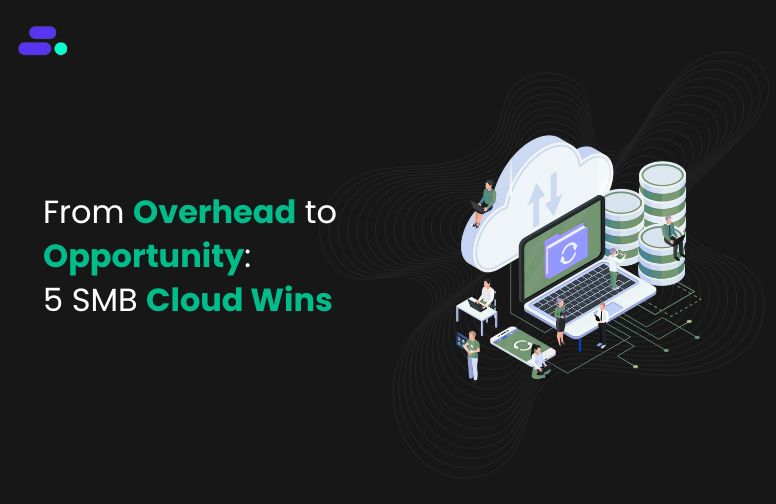
From overhead to opportunity with cloud migration: 5 SMB success stories
For small and mid-sized businesses (SMBs), legacy IT is more than a cost. It's a barrier to growth. On-prem servers, software licenses, and manual maintenance eat up time, budget, and focus. But those who migrate to the cloud are turning that overhead into opportunity. According to Forbes, organizations switching to the cloud have saved over 20% in IT costs.
Along with removing infrastructure burden, cloud migration creates room for innovation. With pay-as-you-go pricing, automated scaling, and simplified operations, SMBs can reinvest resources into customer experience, product development, and faster delivery.
This article explores five real-world success stories of SMBs that modernized with the cloud. These businesses show how shifting from on-prem to AWS helped them cut costs, boost agility, and achieve new growth.
Key takeaways:
- Cloud migration unlocks more than cost savings: Each success story shows that moving to AWS goes beyond reducing infrastructure costs, it's about enabling faster delivery, innovation, and better customer experiences.
- Modernization during migration leads to compounding benefits: SMBs that combine migration with application or data modernization realize greater long-term agility, scalability, and performance.
- Serverless and managed services reduce operational burden: Technologies like AWS Lambda, Step Functions, and Aurora Serverless allow lean teams to build powerful, scalable solutions without needing large internal ops teams.
- The right partner accelerates value, not just migration: Cloudtech’s AWS expertise, SMB focus, and human-centric approach help businesses not only move to the cloud, but also thrive in it, with measurable outcomes from the start.
5 inspiring success stories of cloud transformation
Limited IT budgets, aging infrastructure, and growing pressure to deliver faster, better digital experiences are some of the challenges that SMBs face. What separates the most successful SMBs isn’t just that they migrate to the cloud, it’s how they do it. The right cloud strategy turns overhead into opportunity, allowing even resource-constrained businesses to compete with larger players.
As readers explore the success stories, they’ll likely find parallels with challenges their own business faces, whether it’s costly IT maintenance, fragmented data silos, or sluggish delivery cycles.
Each case illustrates a practical path forward, offering patterns of success that other SMBs can learn from and adapt. These aren’t one-size-fits-all solutions, they’re proof that with a thoughtful cloud strategy, small and mid-sized businesses can scale intelligently, serve customers more effectively, and accelerate growth.
1. SaaS provider modernizes OTT platform with serverless analytics
A SaaS company building OTT video and media applications found its growth hindered by a rigid monolithic backend. As their customer base grew, comprising regional broadcasters and content creators, the platform struggled with slow API performance, unreliable analytics, and a heavy operational load. Scalability became a major concern, especially during live events and regional surges.
Cloud migration strategy: Rather than a simple lift-and-shift, Cloudtech, an AWS Advanced Tier Partner, guided a re-architecture focused on serverless and event-driven design. The team decoupled key services and shifted toward AWS-managed components to reduce infrastructure complexity, enable global scalability, and speed up feature deployment.
What changed?
- Backend modularization: APIs were decoupled and served via Amazon API Gateway and AWS Lambda, improving latency and enabling granular scaling.
- Serverless containers: Stateless services moved to Amazon ECS with AWS Fargate, eliminating manual server provisioning.
- Video streaming: Media delivery was handled via Amazon S3, CloudFront, and AWS Elemental MediaConvert for seamless global streaming.
- Real-time analytics: Data streams were ingested via Amazon Kinesis, processed with AWS Glue, and visualized through Amazon Redshift.
- High availability: Implemented with Aurora Global Database, multi-AZ deployments, and Amazon Route 53 for intelligent DNS-based failover.
- DevOps automation: CI/CD with AWS CodePipeline and end-to-end monitoring via CloudWatch and AWS X-Ray.
Business outcomes: Following the migration, the company reduced platform latency and drastically improved user experience. Buffering issues during high-traffic events dropped by 90%, while real-time analytics enabled partners to adjust content strategy on the fly.
Operational efficiency increased, with infrastructure costs down by 40% and development cycles shortened by weeks. The company is now positioned to expand into new regions without worrying about infrastructure scaling or system downtime.
Key takeaways: This transformation shows how serverless and event-driven architecture can unlock both performance and agility, especially in high-demand media environments. The strategic shift from monolith to modular helped the business operate with startup-level speed at scale.
For SMBs in media and SaaS, moving beyond basic lift-and-shift to embrace a serverless-first strategy can be a game-changer, lowering costs, speeding up delivery, and opening new growth avenues.

2. SaaS platform modernizes music audition with AI-powered feedback
A SaaS platform connecting music students with colleges sought to stand out in a competitive market by enhancing the audition experience using Generative AI. The goal was to deliver real-time, high-quality feedback on tone, rhythm, and expression to improve student practice and provide deeper insights for admissions teams.
Cloud modernization strategy: Rather than disrupting its existing AWS foundations, the platform partnered with Cloudtech to embed a secure, serverless, and event-driven AI workflow into its architecture. This enabled elastic scale during peak audition periods while ensuring fast, contextual feedback using Generative AI hosted in Amazon Bedrock.
What changed?
- AI-enabled feedback loop: Audio uploads were processed using Amazon S3, Amazon Transcribe, and Amazon Bedrock to deliver real-time audition evaluations through a web or chatbot interface.
- Serverless ingestion pipeline: Uploads were secured via Amazon Cognito and API Gateway, triggering AWS Lambda for metadata capture and storage in DynamoDB.
- Asynchronous orchestration: Amazon SQS and EventBridge coordinated event processing and fault isolation across loosely coupled services.
- Observability and resilience: Built-in monitoring with Amazon CloudWatch, X-Ray, and a Dead Letter Queue ensured minimal message loss and easy troubleshooting.
- Compliance by design: IAM roles, AWS Config, and WAF enforced least privilege access and secure API traffic.
- Model refinement: Prompt engineering with chain-of-thought examples and RAG using Titan Embeddings grounded feedback in music theory references.
Business outcomes: The platform saw a 2X increase in audition uploads and a 30% rise in average session time. Latency for AI-generated feedback dropped to under 4 seconds at the 95th percentile. Operational overhead fell by approximately 40% thanks to serverless design.
Educators used the feedback loop to personalize instruction, while colleges gained better alignment between talent and placement. The solution now positions the platform to expand into multilingual and regional markets with minimal rework.
Key takeaways: For SMBs in education or media-tech, embedding Generative AI into an existing AWS foundation doesn’t require a full rebuild. With the right architecture, it’s possible to improve user engagement, reduce operating costs, and introduce innovation at scale, all while maintaining reliability, security, and compliance.

3. Healthcare SaaS platform builds GenAI-driven care experience
A healthcare SaaS platform offering AI-powered care navigation and benefits guidance wanted to improve how users found, understood, and engaged with their health coverage.
With data scattered across systems and FAQs, members struggled with fragmented search, inconsistent information, and limited support personalization. The business needed a way to serve intelligent answers quickly, without rebuilding its backend or disrupting existing systems.
Cloud modernization strategy: Instead of replacing their existing architecture, Cloudtech helped the team embed Generative AI capabilities on top of structured AWS-hosted datasets. Using a retrieval-augmented generation (RAG) approach, the solution combined real-time context with a fine-tuned LLM deployed via Amazon Bedrock Agents.
Serverless orchestration with Step Functions enabled low-latency, multistep queries. Most importantly, the design preserved HIPAA compliance and data governance while transforming how members engaged with the platform.
What changed?
- Intelligent chat interface: Members interact via a GenAI assistant that understands context and retrieves data from multiple sources in seconds.
- RAG-based response generation: Amazon Bedrock Agents connect to indexed Amazon S3 content and Amazon Redshift datasets, allowing the assistant to provide trusted, document-backed answers.
- Secure orchestration: AWS Step Functions and Lambda manage workflows securely, ensuring only compliant data flows to the model.
- Explainable AI: Integrated tracing and content scoring ensure recommendations are auditable and bias-aware.
- Rapid updates: New content is indexed in near real time using Amazon OpenSearch and metadata tagging, ensuring up-to-date responses without re-training.
Business outcomes: The AI assistant reduced support tickets by 45% within two months, while boosting member satisfaction scores. Complex queries that once required manual triage were now resolved in seconds.
Content teams could update documents without touching the AI logic, enabling faster compliance and fewer engineering bottlenecks. By extending and not replacing their AWS architecture, the platform accelerated innovation while staying compliant with healthcare regulations.
Key takeaways: For SMBs in healthcare or information platforms, layering Generative AI on top of structured AWS datasets enables more inclusive, accurate, and conversational user experiences, without rearchitecting the core application.
With the right use of Bedrock Agents, serverless orchestration, and retrieval-augmented generation, it’s possible to improve discoverability, ensure bias-sensitive recommendations, and reduce operating costs, while staying secure and compliant.

4. Healthcare provider ensures HIPAA-compliant data resilience and cuts infra costs
A healthcare provider serving underserved populations in Oregon needed to modernize its legacy EHR infrastructure and improve disaster recovery capabilities. Their on-prem data center sat on an active fault line, putting critical patient records at constant risk.
After the departure of their managed services provider, they were left with outdated systems, complex compliance needs, and an understaffed IT team. To move forward, they needed a secure, cloud-native foundation, without disruption to ongoing care delivery.
Cloud modernization strategy: Cloudtech ran a business-aligned discovery workshop to clarify goals and risks, then delivered a phased AWS implementation. The engagement included AWS Control Tower setup, multi-account governance, and Identity Center configuration.
The centerpiece was a resilient, hybrid data lake on Amazon S3, built with S3 File Gateway and Storage Gateway for EHR and structured file share ingestion. The team also implemented secure VPN connectivity, data lifecycle policies, and automated backup aligned with HIPAA and RPO/RTO requirements. The design emphasized long-term operability, with continuous hands-on training provided to internal teams.
What changed?
- HIPAA-compliant data lake: All EHR and business-critical datasets now reside in an encrypted, durable Amazon S3-based lake.
- Hybrid file access: Amazon S3 File Gateway supports on-prem and cloud file access, easing transition from legacy file servers.
- Secure, multi-account AWS foundation: AWS Organizations, IAM Identity Center, and Directory Service provide centralized access control.
- Disaster-ready backups: Backup policies meet recovery objectives without manual effort or vendor dependence.
- Team enablement: IT staff now independently operate and scale the infrastructure after Cloudtech-led upskilling.
Business outcomes: The provider now saves 77% annually on infrastructure costs after replacing their managed services provider and migrating to AWS. They’ve eliminated data center risks, improved data governance, and gained a scalable, compliant foundation for future analytics and care innovations. Operational resilience has improved significantly, with no disruption to clinical workflows during the migration.
Key takeaways: For healthcare SMBs with compliance-heavy workloads, a resilient AWS data lake built with gateways and hybrid connectivity can modernize infrastructure without losing operational control.
With the right governance setup, backup automation, and team enablement, even critical systems like EHRs can be safely migrated, unlocking major cost savings and setting the stage for long-term digital health innovation.

5. Healthcare insurer modernizes data warehouse and slashes management overhead
A non-profit healthcare insurance provider was struggling to manage and analyze high volumes of data using their on-premises Oracle Exadata system. Growing data complexity made it difficult to maintain performance and cost-efficiency.
The legacy setup required constant trade-offs between storage, ETL complexity, and insight delivery. To modernize their analytics while lowering operational costs, they needed a scalable data warehouse that didn’t demand excessive administration.
Cloud modernization strategy: Cloudtech helped the organization design and implement a modern data processing pipeline using Amazon Redshift and complementary AWS services. Their new architecture follows a streamlined collect-store-analyze-consume model, with Amazon S3 serving as the data lake. AWS Glue manages metadata, and dbt enables data transformation.
Amazon Redshift Spectrum bridges the lake and warehouse, processing data directly from S3 into Redshift tables. Data is then made consumable via Amazon QuickSight dashboards. Redshift’s built-in scalability, compression, and backup features eliminated many of the manual tasks that previously burdened the team.
What changed?
- Modernized data warehouse: Oracle Exadata was replaced with a scalable, cloud-native Redshift setup.
- Improved data accessibility: Redshift Spectrum enabled querying directly from S3 without duplicating storage.
- Lower data ops burden: Auto-scaling, backup, and patching reduced the need for manual maintenance.
- Faster insights: Parallel processing allowed billions of rows to be analyzed simultaneously.
- Seamless integration: AWS Glue, dbt, and QuickSight supported a complete end-to-end data flow.
Business outcomes: The shift to Amazon Redshift gave the insurer a centralized, secure analytics platform that scaled with their needs. Their engineering team no longer had to spend time on infrastructure management, freeing them to focus on delivering insights.
With streamlined ETL pipelines and automated data refreshes, the organization could analyze large datasets in near real-time. As a result, they made better-informed business decisions, with a significantly lower total cost of ownership.
Key takeaways: For SMBs in healthcare or insurance, migrating to Amazon Redshift enables scalable, efficient analytics without the operational pain of legacy systems. By building a cloud-native data warehouse with Amazon S3, AWS Glue, and Amazon Redshift Spectrum, organizations can unlock real-time insights, reduce data ops overhead, and future-proof their analytics investments.

How does Cloudtech enable SMBs to become AWS success stories?
Behind every successful cloud transformation is a partner who understands the nuances of small and mid-sized businesses. Cloudtech, an AWS Advanced Tier Services Partner focused exclusively on SMBs, has helped companies across industries turn cloud migration into real, measurable business value, not just IT change.
Here’s how Cloudtech enables SMBs to translate AWS capabilities into success stories:
- Business-aligned discovery and design: Cloudtech starts each engagement by understanding the client's goals, constraints, and current state. Using AWS tools like Migration Evaluator and Application Discovery Service, they map out what to modernize, migrate, or retire.
- Lean, scalable architectures from day one: Whether it’s a data lake, AI-powered workflow, or serverless application, Cloudtech designs solutions that fit the scale, budget, and future plans of SMBs. They avoid overengineering and use AWS services to minimize operational overhead.
- Security, governance, and resilience built-in: For SMBs with limited IT staff, resilience can’t be an afterthought. Cloudtech builds with best practices from the start, with multi-AZ setups, automated backups, IAM policies, and observability with CloudWatch and GuardDuty, ensuring every workload is secure and monitored.
- Hands-on enablement, not just handoff: Beyond delivery, Cloudtech equips teams with training, documentation, and automation to manage their new environments with confidence. Whether it’s cost dashboards, QuickSight reports, or CI/CD pipelines, every solution includes enablement baked in.
With Cloudtech, SMBs don’t just adopt cloud, they modernize how they operate, innovate, and grow. These success stories reflect a repeatable approach that helps small and mid-sized businesses scale smart, serve better, and stay future-ready on AWS.

Wrapping up
Every SMB featured in these stories started with a common challenge: legacy systems, cost inefficiencies, or operational constraints that limited their ability to grow. What turned things around wasn’t just cloud migration, it was how they utilized AWS, with the right strategy and support, to rethink how their business runs.
These success stories show that cloud transformation isn’t reserved for enterprises. When done right, it enables SMBs to do more with less. They modernize faster, serve customers better, and innovate without being held back by infrastructure or talent gaps.
Cloudtech helps make that possible. With a deep focus on SMBs, Cloudtech brings the technical expertise, business understanding, and AWS alignment needed to turn ambition into action, and action into outcomes.
If your business is ready to modernize with purpose and scale with confidence, Cloudtech is ready to help make you the next AWS success story. Connect with Cloudtech today!
FAQs
1. Is cloud migration worth it for small businesses with limited IT teams?
Yes. In fact, SMBs with lean IT teams often benefit the most. Cloud services like AWS offer managed infrastructure, automated scaling, and built-in security, freeing up teams to focus on core business tasks instead of server maintenance or firefighting outages.
2. How long does it typically take for an SMB to see ROI from a cloud migration?
While timelines vary by use case, many SMBs begin seeing tangible ROI such as cost savings, faster delivery cycles, or improved user experience within the first 3–6 months, especially when migrations are aligned with modernization goals.
3. Do these success stories require large upfront investments?
Not at all. Most of the featured SMBs started small, whether through a phased migration, serverless architecture, or focused workload modernization. Tools like AWS Migration Evaluator help ensure right-sized investments from the start.
4. What if the business has industry-specific compliance needs?
Cloudtech works with SMBs in regulated industries like healthcare, fintech, and education. By using AWS-native services (e.g., AWS Config, GuardDuty, and AWS Backup), compliance and security are built into the solution, not bolted on later.
5. Can I modernize applications during migration, or should that come later?
With the right guidance, both can happen in tandem. In fact, many SMBs accelerate outcomes by modernizing critical parts of their application stack, like moving to serverless or event-driven models, during migration. Cloudtech helps strike the right balance based on business goals and readiness.
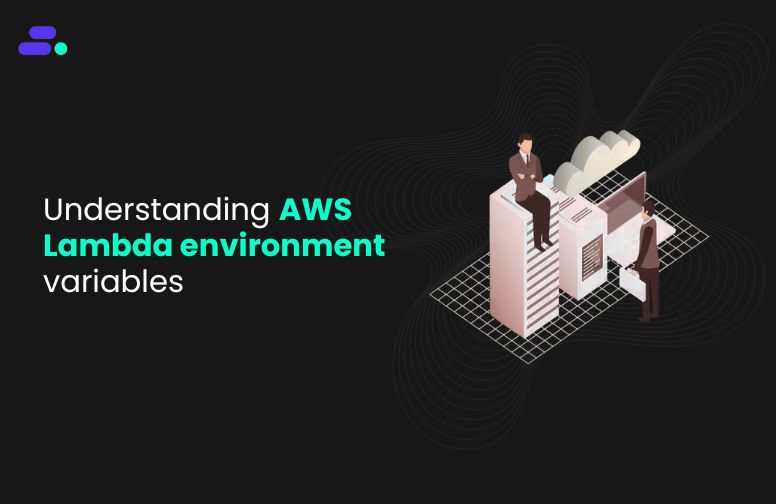
A guide to AWS Lambda environment variables
Consider a growing SaaS company deploying a new feature using AWS Lambda to streamline part of its user workflow. But soon after launch, unexpected behavior surfaced in production. The codebase wasn’t changed, but the function didn’t execute as expected. After a deep dive, the issue is traced back to a simple but critical oversight: a misconfigured environment variable.
For many small and mid-sized businesses (SMBs) adopting serverless on AWS, environment variables in Lambda often fly under the radar—until they don’t. They control how functions connect to services, manage API keys, and handle environment-specific logic. When managed well, they reduce code duplication and speed up deployments. When overlooked, they can introduce bugs that are hard to trace.
This guide provides SMB teams with a practical understanding of AWS Lambda environment variables. From secrets management to debugging strategies, it offers best practices to help teams avoid common missteps and build more reliable serverless applications from the start.
Key takeaways
- Environment variables enable dynamic configuration: Lambda environment variables let businesses change runtime behavior, like API endpoints, feature flags, or logging levels.
- Security starts with proper encryption and access control: AWS automatically encrypts variables using KMS, but using customer-managed keys and IAM least-privilege policies provides stronger protection for sensitive data.
- Tools like AWS Secrets Manager and Parameter Store are better for secrets: Storing credentials directly in environment variables can be risky. Use AWS-native secret managers for secure storage, audit trails, and automatic rotation.
- The Serverless Framework simplifies multi-environment deployments: With stage-specific overrides, secret references, and version-controlled configs, teams can manage complex setups cleanly across dev, staging, and production.
- Following naming conventions and validation improves stability
Clear variable naming, environment-specific separation, and startup validation reduce misconfigurations and deployment issues, especially in growing teams.
What are AWS Lambda environment variables?
AWS Lambda environment variables are key-value pairs used to store configuration data outside of the function code. These variables live within the Lambda execution environment and are accessible via standard access methods (like process.env in Node.js or os.environ in Python), depending on the runtime.
By keeping configuration separate from code, environment variables allow teams to modify runtime behavior without redeploying the function. This is a major advantage for SMBs looking to reduce operational overhead and deployment risk.
Why environment variables matter: Hardcoding configuration values like API keys, database credentials, or feature flags into function code can lead to:
- Increased redeployment cycles for minor changes
- Higher risk of leaking sensitive values through version control
- Reduced ability to reuse code across dev, test, and production environments
Using environment variables helps avoid these issues by enabling:
- Dynamic runtime configuration
- Cleaner separation of code and environment
- Secure, encrypted storage of sensitive values via AWS Key Management Service (KMS)
Here’s how AWS Lambda handles them:
- Immutable at runtime: Environment variables are loaded once per container lifecycle, during the initialization phase. They remain constant throughout the life of that execution environment.
- Encrypted at rest: AWS encrypts environment variables using AWS KMS, ensuring that sensitive data is protected even if access is misconfigured.
- Scoped per version or alias: Businesses can assign different environment variables to each version or alias of their Lambda function, helpful for environment-specific deployments.
Using Lambda environment variables effectively allows SMBs to improve deployment agility, security posture, and operational consistency, especially as serverless architectures scale across teams or environments.

How does AWS Lambda store and load environment variables?
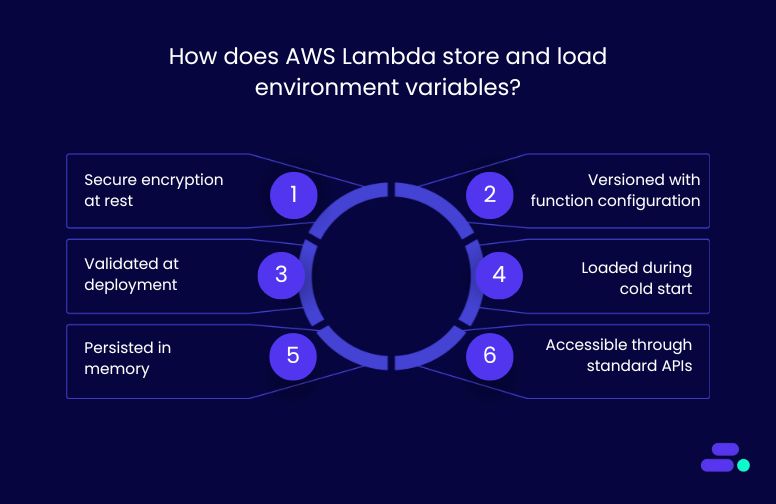
AWS Lambda uses a secure and efficient process to store and load environment variables, enabling functions to behave differently across environments without modifying code. This approach ensures both security and performance throughout the function lifecycle.
1. Secure encryption at rest: Lambda stores all environment variables as part of the function’s configuration and encrypts them using AWS Key Management Service (KMS). This can be either an AWS-managed key or a customer-managed KMS key. These encrypted values are stored with other function settings such as runtime, memory allocation, and timeout duration.
2. Versioned with function configuration: Each time a function is published as a new version, the environment variables are included as part of that version’s configuration. This allows teams to roll back safely or run multiple versions of the same function with different configurations (e.g., dev vs. prod), without affecting stability.
3. Validated at deployment: Lambda automatically validates environment variable syntax and enforces a maximum total size of 4KB per function. This includes all key-value pairs and formatting. If the limit is exceeded or formatting is invalid, the deployment is rejected before it reaches production.
4. Loaded during cold start: When a new execution environment is initialized (a cold start), Lambda decrypts the environment variables using KMS and injects them into the container. This process happens once, before any code is executed, ensuring variables are available from the start.
5. Persisted in memory: After a cold start, environment variables are cached in memory for the duration of the container’s lifecycle. During warm invocations, Lambda does not need to re-decrypt or reload them, improving performance without compromising security.
6. Accessible through standard APIs: Environment variables are made available through standard language-specific APIs:
- process.env in Node.js
- os.environ in Python
- Environment.GetEnvironmentVariable() in .NET
This method allows developers to configure functions dynamically without changing code, reducing deployment cycles and supporting consistent behavior across multiple environments.

How to set environment variables in AWS Lambda?

Environment variables in AWS Lambda can be configured using three main methods, via the AWS Console, CLI, or SDKs, depending on a team’s technical workflow and scale. Each method allows developers to separate runtime configuration from code, streamlining updates without redeploying functions.
1. Using the AWS Management Console
The Console is ideal for smaller teams or quick configuration changes. It provides a user-friendly interface to define up to 50 key-value pairs per function.
- The UI enforces naming rules (alphanumeric characters, underscores, and hyphens).
- A visual indicator tracks usage against the 4KB environment variable size limit.
- Developers can use built-in options to encrypt variables with AWS KMS, selecting region-specific keys.
- JSON import/export makes it easy to reuse environment configurations across multiple functions.
Use case: A healthcare provider running a patient appointment scheduling system on AWS Lambda needs to switch between staging and production API endpoints (e.g., for an EHR system or SMS notification service). Instead of modifying and redeploying the function code, the developer updates the API_URL and FEATURE_TOGGLE_SMS environment variables directly in the AWS Console. This allows the team to change behavior instantly, such as enabling SMS reminders for patients, without code changes or downtime, ensuring faster iteration and reduced operational risk.
2. Using the AWS Command Line Interface (CLI)
The CLI suits engineering teams who manage infrastructure through scripts or version-controlled deployments.
- Environment variables are updated using the update-function-configuration command.
- Only full replacements are allowed. Existing variables are overwritten, not merged.
- Supports configuration via inline input or external JSON files using file://, which helps standardize deployments across stages (e.g., dev, test, prod).
Example:
aws lambda update-function-configuration \
--function-name myFunction \
--environment Variables="{KEY1=value1,KEY2=value2}"
Use case: An SMB operating across development, staging, and production environments, each in separate AWS accounts, needs consistent Lambda configuration for settings like LOG_LEVEL, API_KEY, and REGION_ID. Instead of manually entering these values in each account, the team uses pre-approved JSON files containing environment variable definitions. These files are applied via the AWS CLI or deployment scripts during CI/CD runs, ensuring all environments are configured identically. This approach minimizes human error, speeds up deployments, and maintains compliance with internal governance policies.
3. Using AWS SDKs for automation
For advanced use cases and CI/CD pipelines, the AWS SDKs (e.g., Boto3 for Python, AWS SDK for JavaScript) allow full programmatic control over Lambda environment variables.
- The UpdateFunctionConfiguration API is used to update variables as part of deployment automation.
- SDKs manage authentication, retries, and error handling, reducing the need for custom error logic.
- Teams can build templated variable sets based on client, region, or environment.
Example (Python):
import boto3
lambda_client = boto3.client('lambda')
lambda_client.update_function_configuration(
FunctionName='myFunction',
Environment={'Variables': {'STAGE': 'prod'}}
)
Use case: An SMB software vendor deploying a multi-tenant SaaS solution can use Lambda environment variables to inject client-specific configurations, such as API credentials, feature flags, or tenant identifiers, at deploy time. During CI/CD, the deployment pipeline programmatically updates the Lambda function’s environment based on each customer’s config.
This enables the same Lambda codebase to serve multiple clients securely and efficiently, without hardcoding or redeploying for each tenant. It simplifies onboarding, reduces maintenance, and ensures isolation between customer environments.
These approaches allow SMBs to manage Lambda configurations dynamically, reduce redeployments, and scale operations without introducing complexity. Whether the team prefers a UI-driven approach or automated pipelines, AWS provides flexible tools to meet different operational needs.

Managing AWS Lambda environment variables with the Serverless Framework
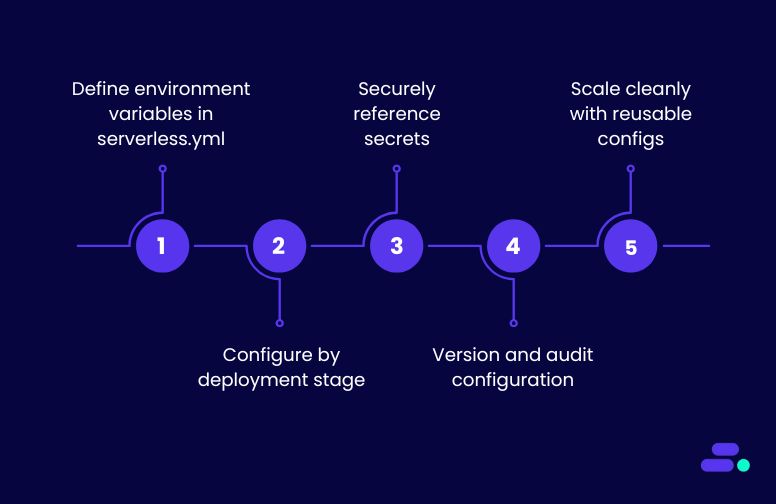
The Serverless Framework enables structured, stage-aware, and secure management of AWS Lambda environment variables using Infrastructure as Code. It allows teams to define, version, and deploy configurations cleanly across environments without embedding secrets in code or relying on manual edits.
Here’s how it works:
1. Define environment variables in serverless.yml
Environment variables can be scoped globally (for all functions) or per function. Variables can be hardcoded, pulled from local .env files, or injected via CI/CD.
provider:
name: aws
environment:
DB_HOST: ${env:DB_HOST}
functions:
myFunction:
environment:
LOG_LEVEL: debug
${env:DB_HOST} pulls values from the machine’s environment or deployment pipeline.
2. Configure by deployment stage
Use the --stage flag to inject different values per environment (e.g., dev, staging, prod). Stage-specific configurations are managed using file overrides or conditional logic.
serverless deploy --stage prod
Businesses can maintain per-stage variable files (env.prod.yml, env.dev.yml) and reference them using the file() directive in serverless.yml.
3. Securely reference secrets
Instead of hardcoding sensitive values, reference AWS Secrets Manager or SSM Parameter Store:
environment:
DB_PASSWORD: ${ssm:/prod/db/password~true}
The ~true flag ensures the value is decrypted. Secrets remain outside version control and are encrypted at rest.
4. Version and audit configuration
Since serverless.yml is part of source control, teams get full version history and rollback capability. This promotes consistent deployments and improves collaboration between dev and ops teams.
5. Scale cleanly with reusable configs
For large projects, use separate serverless.yml files per stage or modularize config using serverless.ts or YAML imports:
custom: ${file(./config.${opt:stage, 'dev'}.yml)}
This keeps configuration DRY while supporting stage-specific overrides.
By using the Serverless Framework, SMBs can manage Lambda environment variables securely, scalably, and with full automation, minimizing misconfigurations and accelerating deployment workflows.

How to secure AWS Lambda environment variables?
When Lambda functions handle sensitive values like database passwords or API tokens, securing environment variables is essential. Misconfiguration can lead to data exposure or compliance violations. AWS offers several tools to help, if used correctly.
1. Encryption with AWS KMS: All Lambda environment variables are encrypted at rest using AWS Key Management Service (KMS). By default, AWS uses its managed keys, but for sensitive workloads, SMBs should use customer-managed keys for better control. This allows teams to define key-specific IAM policies, track usage with CloudTrail, and enforce rotation policies. The KMSKeyArn field in the Lambda configuration lets the teams specify the custom key. No application code changes are required, as decryption is handled during function startup.
2. Storing secrets securely: Avoid embedding sensitive data directly in environment variables. Instead, store secrets in AWS Secrets Manager or Systems Manager Parameter Store. These services support fine-grained access control, logging, and automatic rotation (especially for RDS). Lambda functions can reference these secrets via ARNs in environment variables and retrieve them at runtime using the AWS SDK.
Example:
DATABASE_PASSWORD_SECRET_ARN: arn:aws:secretsmanager:us-east-1:...
3. IAM-based access control: Limit who and what can access secrets or decrypt environment variables. Use least-privilege IAM roles that restrict access to specific secrets or KMS keys. This helps isolate workloads and reduces blast radius in case of compromise. Use tools like IAM Access Analyzer to audit permissions regularly.
Combining encryption, secret management, and tight access control allows SMBs to ensure that Lambda-based applications handle sensitive configuration securely without sacrificing agility.
Best practices when using AWS Lambda environment variables
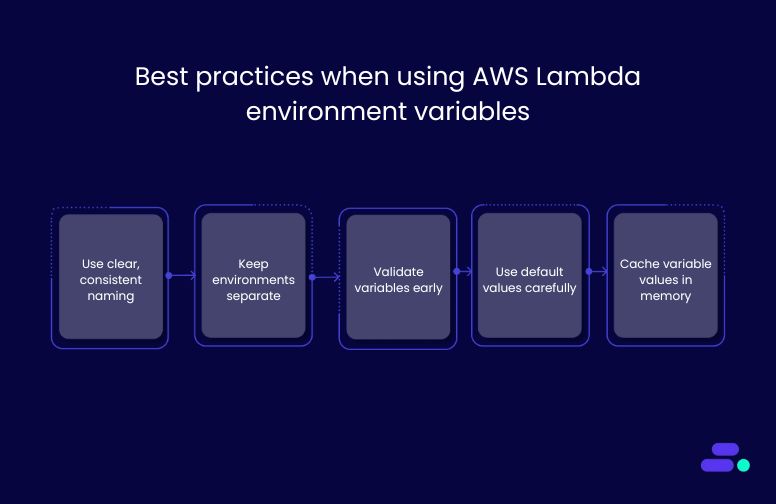
Environment variables in AWS Lambda provide a simple but powerful way to manage configuration without modifying code. By storing key values like database URLs, API keys, feature flags, or timeout settings outside the application logic, teams can run the same code across different environments with varying configurations.
For SMBs running lean teams or managing multiple client deployments, this separation of config from code offers speed and flexibility. There is no need to redeploy just to update a setting. Lambda environment variables are injected during the container’s cold start, made available as part of the runtime’s native environment (e.g., process.env in Node.js or os.environ in Python), and cached throughout the function's lifecycle for consistent performance.
However, poor environment variable practices can lead to runtime errors, security gaps, or debugging headaches. That’s why teams must structure, validate, and scope environment variables thoughtfully. The following best practices ensure the Lambda functions stay secure, scalable, and maintainable as the business and workloads grow.
1. Use clear, consistent naming: Stick to uppercase, underscore-separated names like PAYMENTS_API_KEY or ORDERS_DB_URL. Prefix variables with the service or app name (e.g., ORDERS_DB_URL) to avoid confusion or conflicts in shared environments.
2. Keep environments separate: Don’t mix dev, staging, and prod variables. Use environment-specific names like DB_URL_PROD vs. DB_URL_DEV. This prevents accidental access to production data during testing.
3. Validate variables early: Add startup checks to confirm that all required environment variables are present and correctly formatted. Catching misconfigurations upfront avoids runtime failures and debugging delays.
4. Use default values carefully: Set safe defaults only for non-sensitive settings, like timeouts or feature flags. Never default values like passwords or API keys; always set those explicitly.
5. Cache variable values in memory: Instead of re-reading or re-parsing environment variables on every function call, load them once during initialization. This improves performance and reduces compute costs, especially for high-frequency invocations.
These practices help SMBs build secure, reliable Lambda functions that are easier to scale and maintain.

How Cloudtech helps SMBs implement secure AWS Lambda configuration
Misconfigured environment variables can lead to broken deployments, leaked secrets, and unstable behavior across environments. Cloudtech helps small and mid-sized businesses solve these problems by designing serverless systems that prioritize secure, stage-aware configuration from the start.
Each of Cloudtech’s core services supports this goal:
- Application modernization: Cloudtech transforms monolithic or legacy applications into AWS-native systems where environment variables are managed dynamically. This ensures clean separation between code and configuration, enabling safer deployments and easier multi-environment support without manual rewrites.
- Infrastructure resiliency: Cloudtech’s infrastructure solutions embed best practices for runtime configuration, including encrypted environment variables, stage-specific resource isolation, and consistent IAM scoping. Teams gain better control over what their functions access.
- Data modernization: Cloudtech replaces fragile in-code credentials with centralized secret management using AWS Secrets Manager and Parameter Store. This reduces the risk of exposure, supports key rotation, and integrates cleanly with Lambda environment variable references.
- Generative AI: For teams building AI-powered features on Lambda, Cloudtech helps structure workloads with environment-specific tuning, model versioning, and secure access to APIs or feature flags, all configured safely outside the codebase.

Conclusion
Effective Lambda environment variable management depends on clear naming, strict environment separation, and secure configuration handling. When supported by automation and secret management, these practices reduce errors, improve consistency, and make serverless deployments easier to scale and manage.
For SMBs building on AWS, getting this right is key to long-term stability and efficiency. Cloudtech helps teams implement these best practices through application modernization, infrastructure design, secure data handling, and automation support. Contact us to build safer, more manageable serverless systems.
FAQ’s
1. How do businesses deploy environment variables in Lambda?
Environment variables in AWS Lambda can be deployed using the AWS Management Console, AWS CLI, SDKs, or Infrastructure-as-Code tools. Values are stored as key-value pairs and attached to the function’s configuration during deployment or update processes.
2. Does AWS Lambda encrypt environment variables?
Yes, AWS Lambda encrypts all environment variables at rest using AWS Key Management Service (KMS). Developers can use either AWS-managed keys or customer-managed keys to control access, enable auditing, and support encryption policies required for compliance and data security.
3. How to get environment variables in Lambda Java?
Lambda functions written in Java can access environment variables using System.getenv("VARIABLE_NAME"). These values are available during function initialization and remain accessible throughout the execution lifecycle, allowing developers to configure runtime behavior without modifying or redeploying function code.
4. How do I set environment variables in AWS?
Environment variables can be set in AWS Lambda through the Management Console, AWS CLI, or SDKs. Each method requires defining key-value pairs that meet naming constraints and fit within the total 4KB size limit for all environment variables combined.
5. What is a Lambda execution environment?
The Lambda execution environment is a managed runtime that hosts function code in an isolated container. It includes system libraries, runtime binaries, and environment variables, and it handles code initialization, invocation processing, and resource lifecycle management across cold and warm starts.
Get started on your cloud modernization journey today!
Let Cloudtech build a modern AWS infrastructure that’s right for your business.
